Strategic Analysis of Amazon's Marketing Strategy
VerifiedAdded on 2023/02/13
|27
|8177
|63
AI Summary
This document provides a strategic analysis of Amazon's marketing strategy. It includes an introduction to the company, market summary, market demographics, PEST analysis, SWOT analysis, analysis of the competition, and an analysis of the marketing mix. The document also offers conclusions and recommendations. The subject is marketing and the course code is not mentioned. The document type is a final project.
Contribute Materials
Your contribution can guide someone’s learning journey. Share your
documents today.
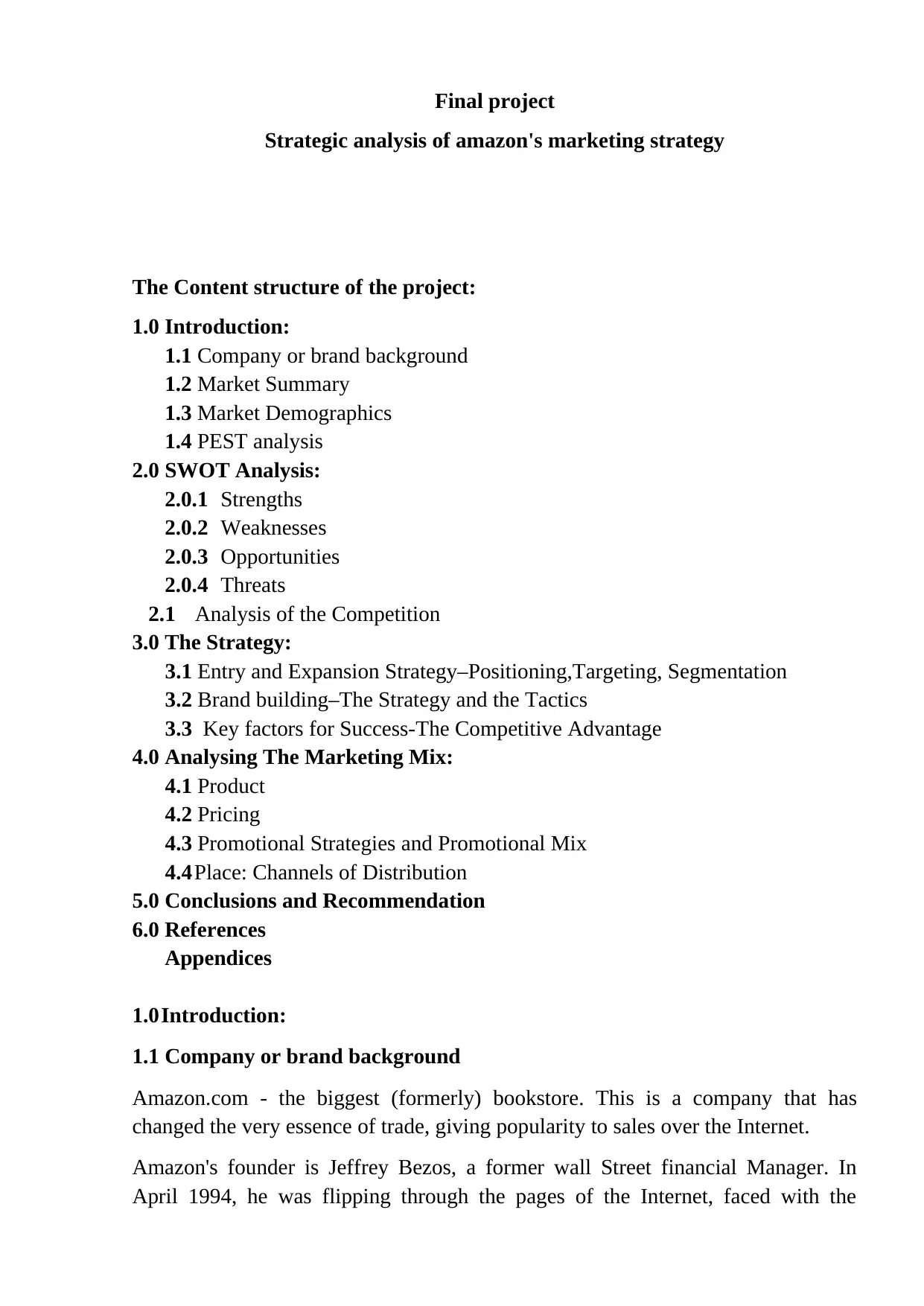
Final project
Strategic analysis of amazon's marketing strategy
The Content structure of the project:
1.0 Introduction:
1.1 Company or brand background
1.2 Market Summary
1.3 Market Demographics
1.4 PEST analysis
2.0 SWOT Analysis:
2.0.1 Strengths
2.0.2 Weaknesses
2.0.3 Opportunities
2.0.4 Threats
2.1 Analysis of the Competition
3.0 The Strategy:
3.1 Entry and Expansion Strategy–Positioning,Targeting, Segmentation
3.2 Brand building–The Strategy and the Tactics
3.3 Key factors for Success-The Competitive Advantage
4.0 Analysing The Marketing Mix:
4.1 Product
4.2 Pricing
4.3 Promotional Strategies and Promotional Mix
4.4Place: Channels of Distribution
5.0 Conclusions and Recommendation
6.0 References
Appendices
1.0Introduction:
1.1 Company or brand background
Amazon.com - the biggest (formerly) bookstore. This is a company that has
changed the very essence of trade, giving popularity to sales over the Internet.
Amazon's founder is Jeffrey Bezos, a former wall Street financial Manager. In
April 1994, he was flipping through the pages of the Internet, faced with the
Strategic analysis of amazon's marketing strategy
The Content structure of the project:
1.0 Introduction:
1.1 Company or brand background
1.2 Market Summary
1.3 Market Demographics
1.4 PEST analysis
2.0 SWOT Analysis:
2.0.1 Strengths
2.0.2 Weaknesses
2.0.3 Opportunities
2.0.4 Threats
2.1 Analysis of the Competition
3.0 The Strategy:
3.1 Entry and Expansion Strategy–Positioning,Targeting, Segmentation
3.2 Brand building–The Strategy and the Tactics
3.3 Key factors for Success-The Competitive Advantage
4.0 Analysing The Marketing Mix:
4.1 Product
4.2 Pricing
4.3 Promotional Strategies and Promotional Mix
4.4Place: Channels of Distribution
5.0 Conclusions and Recommendation
6.0 References
Appendices
1.0Introduction:
1.1 Company or brand background
Amazon.com - the biggest (formerly) bookstore. This is a company that has
changed the very essence of trade, giving popularity to sales over the Internet.
Amazon's founder is Jeffrey Bezos, a former wall Street financial Manager. In
April 1994, he was flipping through the pages of the Internet, faced with the
Secure Best Marks with AI Grader
Need help grading? Try our AI Grader for instant feedback on your assignments.
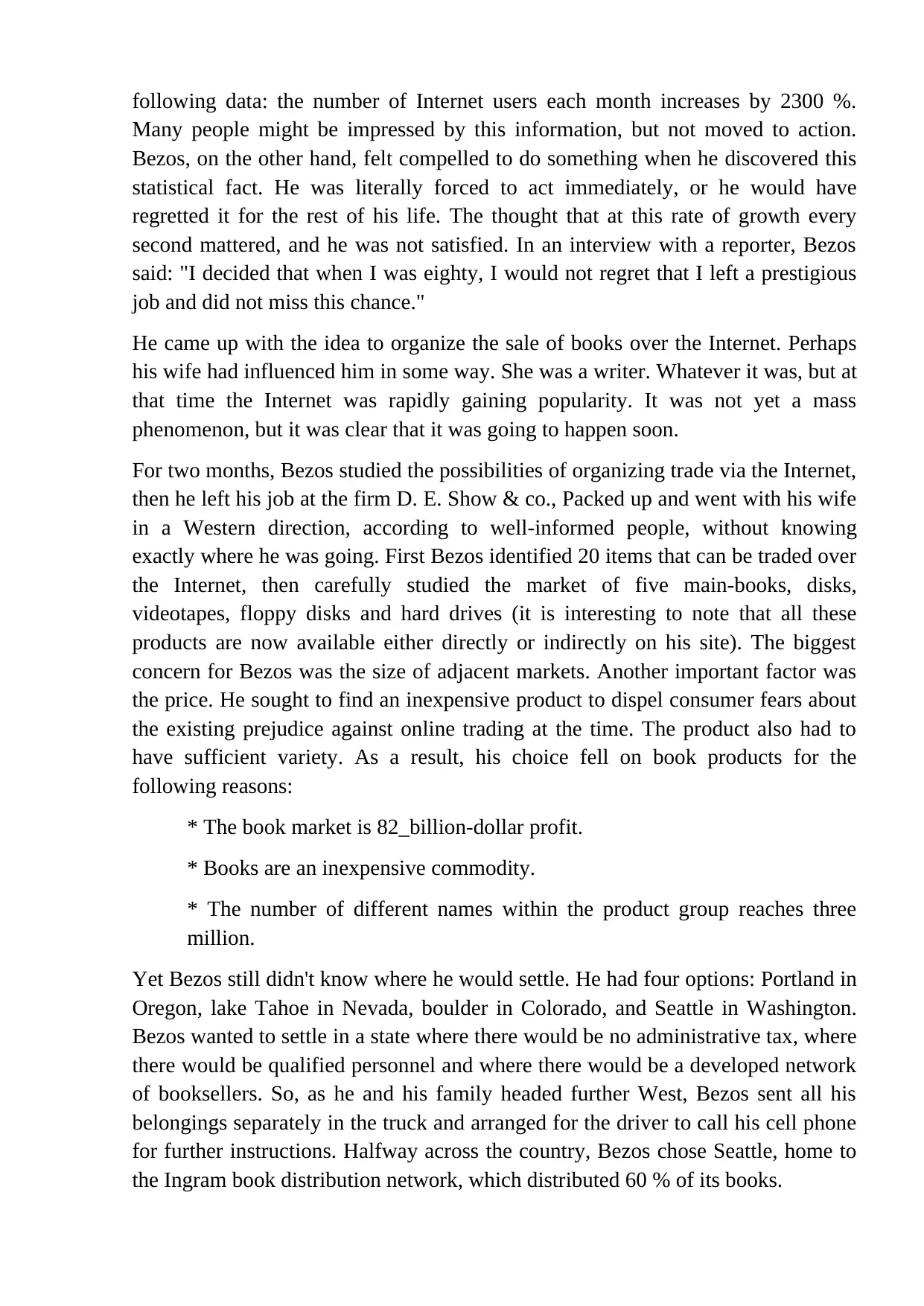
following data: the number of Internet users each month increases by 2300 %.
Many people might be impressed by this information, but not moved to action.
Bezos, on the other hand, felt compelled to do something when he discovered this
statistical fact. He was literally forced to act immediately, or he would have
regretted it for the rest of his life. The thought that at this rate of growth every
second mattered, and he was not satisfied. In an interview with a reporter, Bezos
said: "I decided that when I was eighty, I would not regret that I left a prestigious
job and did not miss this chance."
He came up with the idea to organize the sale of books over the Internet. Perhaps
his wife had influenced him in some way. She was a writer. Whatever it was, but at
that time the Internet was rapidly gaining popularity. It was not yet a mass
phenomenon, but it was clear that it was going to happen soon.
For two months, Bezos studied the possibilities of organizing trade via the Internet,
then he left his job at the firm D. E. Show & co., Packed up and went with his wife
in a Western direction, according to well-informed people, without knowing
exactly where he was going. First Bezos identified 20 items that can be traded over
the Internet, then carefully studied the market of five main-books, disks,
videotapes, floppy disks and hard drives (it is interesting to note that all these
products are now available either directly or indirectly on his site). The biggest
concern for Bezos was the size of adjacent markets. Another important factor was
the price. He sought to find an inexpensive product to dispel consumer fears about
the existing prejudice against online trading at the time. The product also had to
have sufficient variety. As a result, his choice fell on book products for the
following reasons:
* The book market is 82_billion-dollar profit.
* Books are an inexpensive commodity.
* The number of different names within the product group reaches three
million.
Yet Bezos still didn't know where he would settle. He had four options: Portland in
Oregon, lake Tahoe in Nevada, boulder in Colorado, and Seattle in Washington.
Bezos wanted to settle in a state where there would be no administrative tax, where
there would be qualified personnel and where there would be a developed network
of booksellers. So, as he and his family headed further West, Bezos sent all his
belongings separately in the truck and arranged for the driver to call his cell phone
for further instructions. Halfway across the country, Bezos chose Seattle, home to
the Ingram book distribution network, which distributed 60 % of its books.
Many people might be impressed by this information, but not moved to action.
Bezos, on the other hand, felt compelled to do something when he discovered this
statistical fact. He was literally forced to act immediately, or he would have
regretted it for the rest of his life. The thought that at this rate of growth every
second mattered, and he was not satisfied. In an interview with a reporter, Bezos
said: "I decided that when I was eighty, I would not regret that I left a prestigious
job and did not miss this chance."
He came up with the idea to organize the sale of books over the Internet. Perhaps
his wife had influenced him in some way. She was a writer. Whatever it was, but at
that time the Internet was rapidly gaining popularity. It was not yet a mass
phenomenon, but it was clear that it was going to happen soon.
For two months, Bezos studied the possibilities of organizing trade via the Internet,
then he left his job at the firm D. E. Show & co., Packed up and went with his wife
in a Western direction, according to well-informed people, without knowing
exactly where he was going. First Bezos identified 20 items that can be traded over
the Internet, then carefully studied the market of five main-books, disks,
videotapes, floppy disks and hard drives (it is interesting to note that all these
products are now available either directly or indirectly on his site). The biggest
concern for Bezos was the size of adjacent markets. Another important factor was
the price. He sought to find an inexpensive product to dispel consumer fears about
the existing prejudice against online trading at the time. The product also had to
have sufficient variety. As a result, his choice fell on book products for the
following reasons:
* The book market is 82_billion-dollar profit.
* Books are an inexpensive commodity.
* The number of different names within the product group reaches three
million.
Yet Bezos still didn't know where he would settle. He had four options: Portland in
Oregon, lake Tahoe in Nevada, boulder in Colorado, and Seattle in Washington.
Bezos wanted to settle in a state where there would be no administrative tax, where
there would be qualified personnel and where there would be a developed network
of booksellers. So, as he and his family headed further West, Bezos sent all his
belongings separately in the truck and arranged for the driver to call his cell phone
for further instructions. Halfway across the country, Bezos chose Seattle, home to
the Ingram book distribution network, which distributed 60 % of its books.
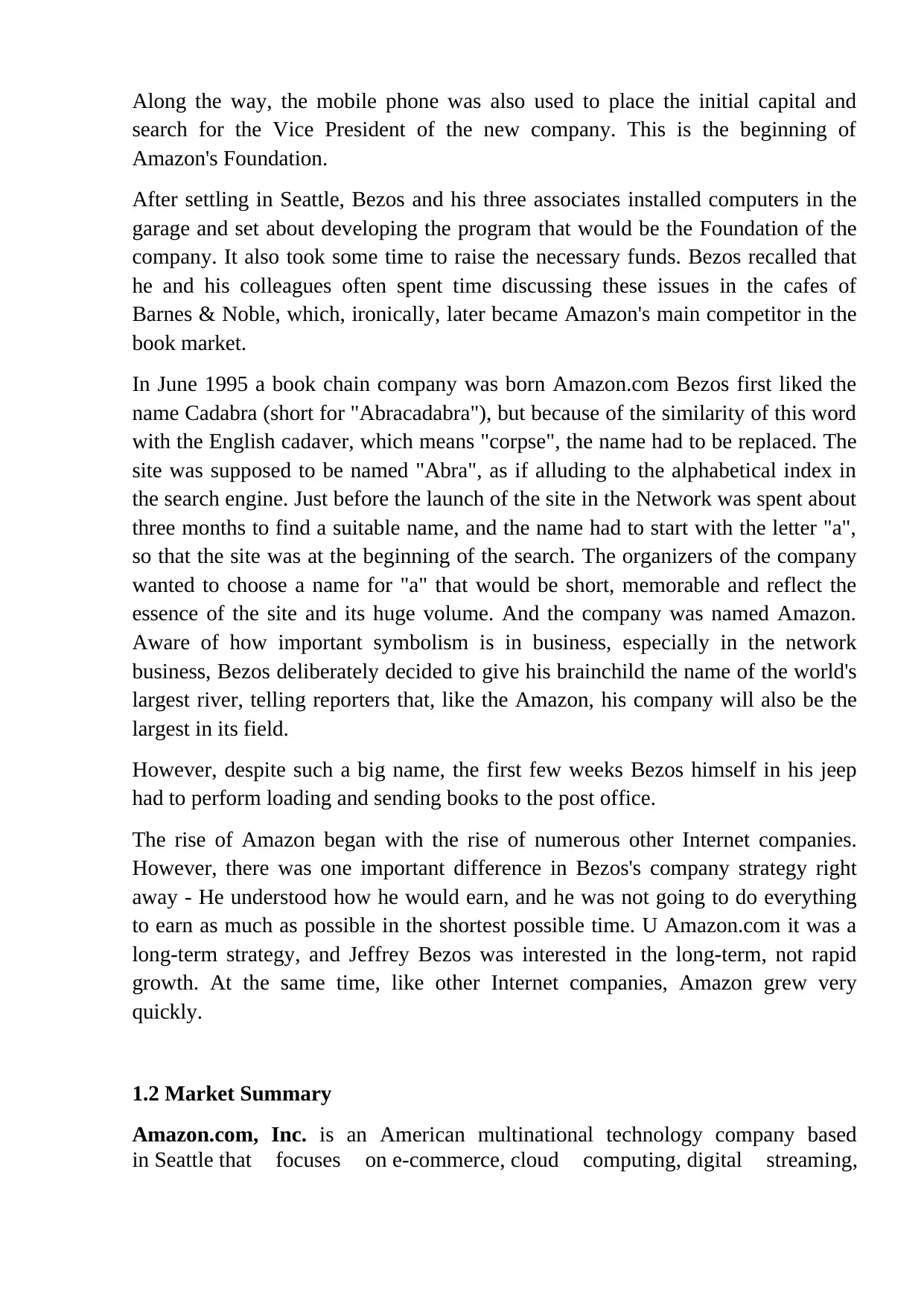
Along the way, the mobile phone was also used to place the initial capital and
search for the Vice President of the new company. This is the beginning of
Amazon's Foundation.
After settling in Seattle, Bezos and his three associates installed computers in the
garage and set about developing the program that would be the Foundation of the
company. It also took some time to raise the necessary funds. Bezos recalled that
he and his colleagues often spent time discussing these issues in the cafes of
Barnes & Noble, which, ironically, later became Amazon's main competitor in the
book market.
In June 1995 a book chain company was born Amazon.com Bezos first liked the
name Cadabra (short for "Abracadabra"), but because of the similarity of this word
with the English cadaver, which means "corpse", the name had to be replaced. The
site was supposed to be named "Abra", as if alluding to the alphabetical index in
the search engine. Just before the launch of the site in the Network was spent about
three months to find a suitable name, and the name had to start with the letter "a",
so that the site was at the beginning of the search. The organizers of the company
wanted to choose a name for "a" that would be short, memorable and reflect the
essence of the site and its huge volume. And the company was named Amazon.
Aware of how important symbolism is in business, especially in the network
business, Bezos deliberately decided to give his brainchild the name of the world's
largest river, telling reporters that, like the Amazon, his company will also be the
largest in its field.
However, despite such a big name, the first few weeks Bezos himself in his jeep
had to perform loading and sending books to the post office.
The rise of Amazon began with the rise of numerous other Internet companies.
However, there was one important difference in Bezos's company strategy right
away - He understood how he would earn, and he was not going to do everything
to earn as much as possible in the shortest possible time. U Amazon.com it was a
long-term strategy, and Jeffrey Bezos was interested in the long-term, not rapid
growth. At the same time, like other Internet companies, Amazon grew very
quickly.
1.2 Market Summary
Amazon.com, Inc. is an American multinational technology company based
in Seattle that focuses on e-commerce, cloud computing, digital streaming,
search for the Vice President of the new company. This is the beginning of
Amazon's Foundation.
After settling in Seattle, Bezos and his three associates installed computers in the
garage and set about developing the program that would be the Foundation of the
company. It also took some time to raise the necessary funds. Bezos recalled that
he and his colleagues often spent time discussing these issues in the cafes of
Barnes & Noble, which, ironically, later became Amazon's main competitor in the
book market.
In June 1995 a book chain company was born Amazon.com Bezos first liked the
name Cadabra (short for "Abracadabra"), but because of the similarity of this word
with the English cadaver, which means "corpse", the name had to be replaced. The
site was supposed to be named "Abra", as if alluding to the alphabetical index in
the search engine. Just before the launch of the site in the Network was spent about
three months to find a suitable name, and the name had to start with the letter "a",
so that the site was at the beginning of the search. The organizers of the company
wanted to choose a name for "a" that would be short, memorable and reflect the
essence of the site and its huge volume. And the company was named Amazon.
Aware of how important symbolism is in business, especially in the network
business, Bezos deliberately decided to give his brainchild the name of the world's
largest river, telling reporters that, like the Amazon, his company will also be the
largest in its field.
However, despite such a big name, the first few weeks Bezos himself in his jeep
had to perform loading and sending books to the post office.
The rise of Amazon began with the rise of numerous other Internet companies.
However, there was one important difference in Bezos's company strategy right
away - He understood how he would earn, and he was not going to do everything
to earn as much as possible in the shortest possible time. U Amazon.com it was a
long-term strategy, and Jeffrey Bezos was interested in the long-term, not rapid
growth. At the same time, like other Internet companies, Amazon grew very
quickly.
1.2 Market Summary
Amazon.com, Inc. is an American multinational technology company based
in Seattle that focuses on e-commerce, cloud computing, digital streaming,
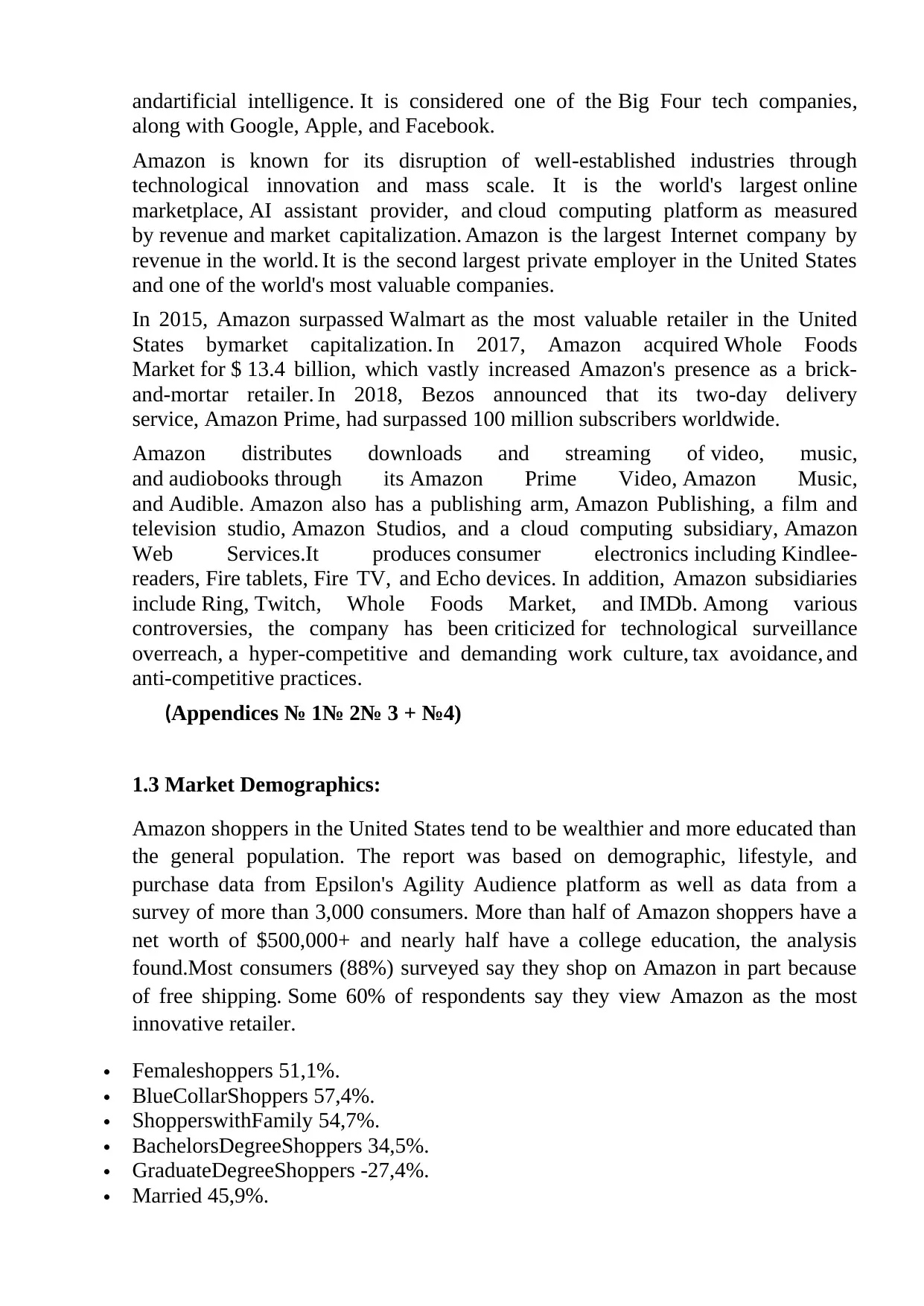
andartificial intelligence. It is considered one of the Big Four tech companies,
along with Google, Apple, and Facebook.
Amazon is known for its disruption of well-established industries through
technological innovation and mass scale. It is the world's largest online
marketplace, AI assistant provider, and cloud computing platform as measured
by revenue and market capitalization. Amazon is the largest Internet company by
revenue in the world. It is the second largest private employer in the United States
and one of the world's most valuable companies.
In 2015, Amazon surpassed Walmart as the most valuable retailer in the United
States bymarket capitalization. In 2017, Amazon acquired Whole Foods
Market for $ 13.4 billion, which vastly increased Amazon's presence as a brick-
and-mortar retailer. In 2018, Bezos announced that its two-day delivery
service, Amazon Prime, had surpassed 100 million subscribers worldwide.
Amazon distributes downloads and streaming of video, music,
and audiobooks through its Amazon Prime Video, Amazon Music,
and Audible. Amazon also has a publishing arm, Amazon Publishing, a film and
television studio, Amazon Studios, and a cloud computing subsidiary, Amazon
Web Services.It produces consumer electronics including Kindlee-
readers, Fire tablets, Fire TV, and Echo devices. In addition, Amazon subsidiaries
include Ring, Twitch, Whole Foods Market, and IMDb. Among various
controversies, the company has been criticized for technological surveillance
overreach, a hyper-competitive and demanding work culture, tax avoidance, and
anti-competitive practices.
(Appendices № 1№ 2№ 3 + №4)
1.3 Market Demographics:
Amazon shoppers in the United States tend to be wealthier and more educated than
the general population. The report was based on demographic, lifestyle, and
purchase data from Epsilon's Agility Audience platform as well as data from a
survey of more than 3,000 consumers. More than half of Amazon shoppers have a
net worth of $500,000+ and nearly half have a college education, the analysis
found.Most consumers (88%) surveyed say they shop on Amazon in part because
of free shipping. Some 60% of respondents say they view Amazon as the most
innovative retailer.
Femaleshoppers 51,1%.
BlueCollarShoppers 57,4%.
ShopperswithFamily 54,7%.
BachelorsDegreeShoppers 34,5%.
GraduateDegreeShoppers -27,4%.
Married 45,9%.
along with Google, Apple, and Facebook.
Amazon is known for its disruption of well-established industries through
technological innovation and mass scale. It is the world's largest online
marketplace, AI assistant provider, and cloud computing platform as measured
by revenue and market capitalization. Amazon is the largest Internet company by
revenue in the world. It is the second largest private employer in the United States
and one of the world's most valuable companies.
In 2015, Amazon surpassed Walmart as the most valuable retailer in the United
States bymarket capitalization. In 2017, Amazon acquired Whole Foods
Market for $ 13.4 billion, which vastly increased Amazon's presence as a brick-
and-mortar retailer. In 2018, Bezos announced that its two-day delivery
service, Amazon Prime, had surpassed 100 million subscribers worldwide.
Amazon distributes downloads and streaming of video, music,
and audiobooks through its Amazon Prime Video, Amazon Music,
and Audible. Amazon also has a publishing arm, Amazon Publishing, a film and
television studio, Amazon Studios, and a cloud computing subsidiary, Amazon
Web Services.It produces consumer electronics including Kindlee-
readers, Fire tablets, Fire TV, and Echo devices. In addition, Amazon subsidiaries
include Ring, Twitch, Whole Foods Market, and IMDb. Among various
controversies, the company has been criticized for technological surveillance
overreach, a hyper-competitive and demanding work culture, tax avoidance, and
anti-competitive practices.
(Appendices № 1№ 2№ 3 + №4)
1.3 Market Demographics:
Amazon shoppers in the United States tend to be wealthier and more educated than
the general population. The report was based on demographic, lifestyle, and
purchase data from Epsilon's Agility Audience platform as well as data from a
survey of more than 3,000 consumers. More than half of Amazon shoppers have a
net worth of $500,000+ and nearly half have a college education, the analysis
found.Most consumers (88%) surveyed say they shop on Amazon in part because
of free shipping. Some 60% of respondents say they view Amazon as the most
innovative retailer.
Femaleshoppers 51,1%.
BlueCollarShoppers 57,4%.
ShopperswithFamily 54,7%.
BachelorsDegreeShoppers 34,5%.
GraduateDegreeShoppers -27,4%.
Married 45,9%.
Secure Best Marks with AI Grader
Need help grading? Try our AI Grader for instant feedback on your assignments.
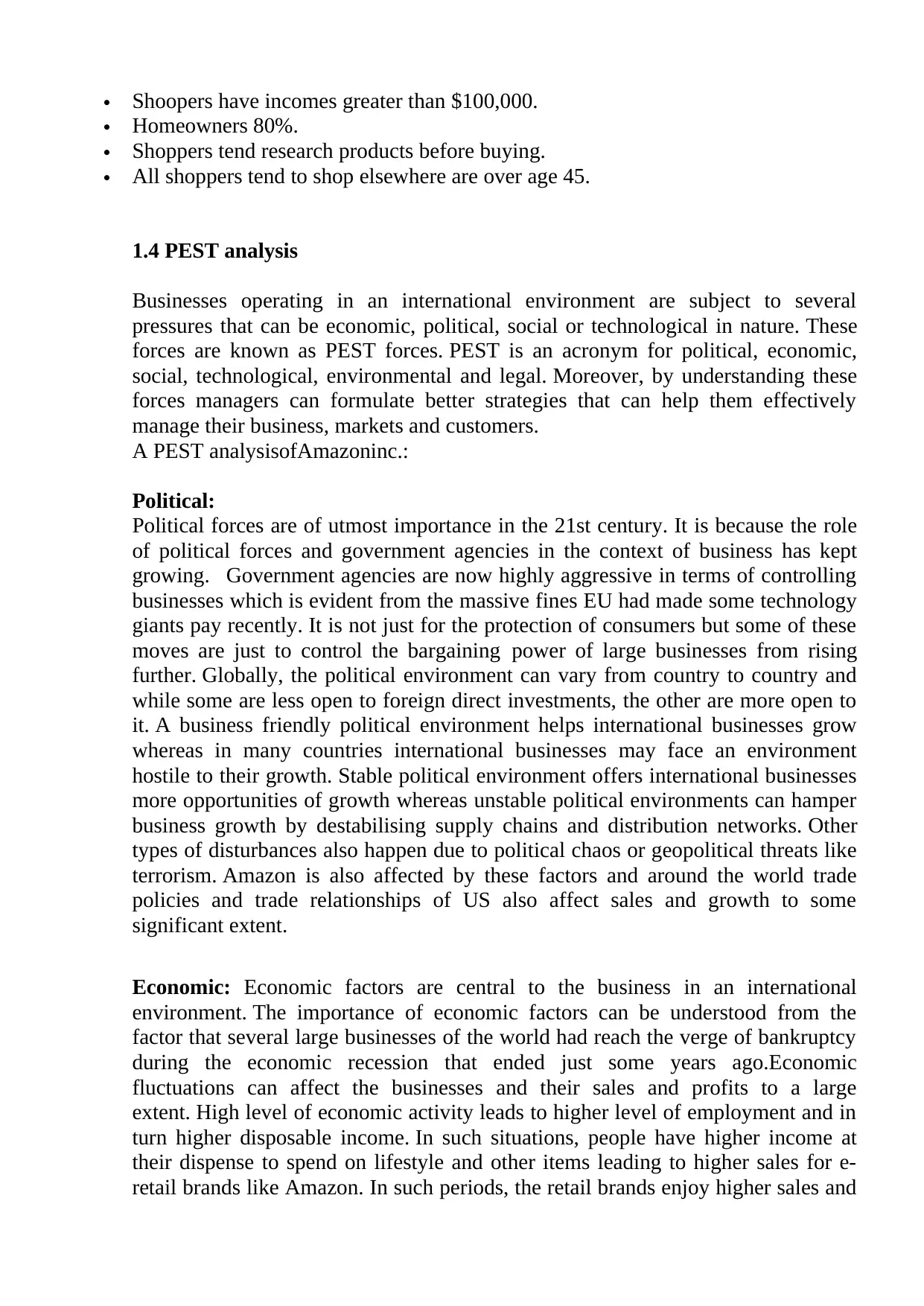
Shoopers have incomes greater than $100,000.
Homeowners 80%.
Shoppers tend research products before buying.
All shoppers tend to shop elsewhere are over age 45.
1.4 PEST analysis
Businesses operating in an international environment are subject to several
pressures that can be economic, political, social or technological in nature. These
forces are known as PEST forces. PEST is an acronym for political, economic,
social, technological, environmental and legal. Moreover, by understanding these
forces managers can formulate better strategies that can help them effectively
manage their business, markets and customers.
A PEST analysisofAmazoninc.:
Political:
Political forces are of utmost importance in the 21st century. It is because the role
of political forces and government agencies in the context of business has kept
growing. Government agencies are now highly aggressive in terms of controlling
businesses which is evident from the massive fines EU had made some technology
giants pay recently. It is not just for the protection of consumers but some of these
moves are just to control the bargaining power of large businesses from rising
further. Globally, the political environment can vary from country to country and
while some are less open to foreign direct investments, the other are more open to
it. A business friendly political environment helps international businesses grow
whereas in many countries international businesses may face an environment
hostile to their growth. Stable political environment offers international businesses
more opportunities of growth whereas unstable political environments can hamper
business growth by destabilising supply chains and distribution networks. Other
types of disturbances also happen due to political chaos or geopolitical threats like
terrorism. Amazon is also affected by these factors and around the world trade
policies and trade relationships of US also affect sales and growth to some
significant extent.
Economic: Economic factors are central to the business in an international
environment. The importance of economic factors can be understood from the
factor that several large businesses of the world had reach the verge of bankruptcy
during the economic recession that ended just some years ago.Economic
fluctuations can affect the businesses and their sales and profits to a large
extent. High level of economic activity leads to higher level of employment and in
turn higher disposable income. In such situations, people have higher income at
their dispense to spend on lifestyle and other items leading to higher sales for e-
retail brands like Amazon. In such periods, the retail brands enjoy higher sales and
Homeowners 80%.
Shoppers tend research products before buying.
All shoppers tend to shop elsewhere are over age 45.
1.4 PEST analysis
Businesses operating in an international environment are subject to several
pressures that can be economic, political, social or technological in nature. These
forces are known as PEST forces. PEST is an acronym for political, economic,
social, technological, environmental and legal. Moreover, by understanding these
forces managers can formulate better strategies that can help them effectively
manage their business, markets and customers.
A PEST analysisofAmazoninc.:
Political:
Political forces are of utmost importance in the 21st century. It is because the role
of political forces and government agencies in the context of business has kept
growing. Government agencies are now highly aggressive in terms of controlling
businesses which is evident from the massive fines EU had made some technology
giants pay recently. It is not just for the protection of consumers but some of these
moves are just to control the bargaining power of large businesses from rising
further. Globally, the political environment can vary from country to country and
while some are less open to foreign direct investments, the other are more open to
it. A business friendly political environment helps international businesses grow
whereas in many countries international businesses may face an environment
hostile to their growth. Stable political environment offers international businesses
more opportunities of growth whereas unstable political environments can hamper
business growth by destabilising supply chains and distribution networks. Other
types of disturbances also happen due to political chaos or geopolitical threats like
terrorism. Amazon is also affected by these factors and around the world trade
policies and trade relationships of US also affect sales and growth to some
significant extent.
Economic: Economic factors are central to the business in an international
environment. The importance of economic factors can be understood from the
factor that several large businesses of the world had reach the verge of bankruptcy
during the economic recession that ended just some years ago.Economic
fluctuations can affect the businesses and their sales and profits to a large
extent. High level of economic activity leads to higher level of employment and in
turn higher disposable income. In such situations, people have higher income at
their dispense to spend on lifestyle and other items leading to higher sales for e-
retail brands like Amazon. In such periods, the retail brands enjoy higher sales and
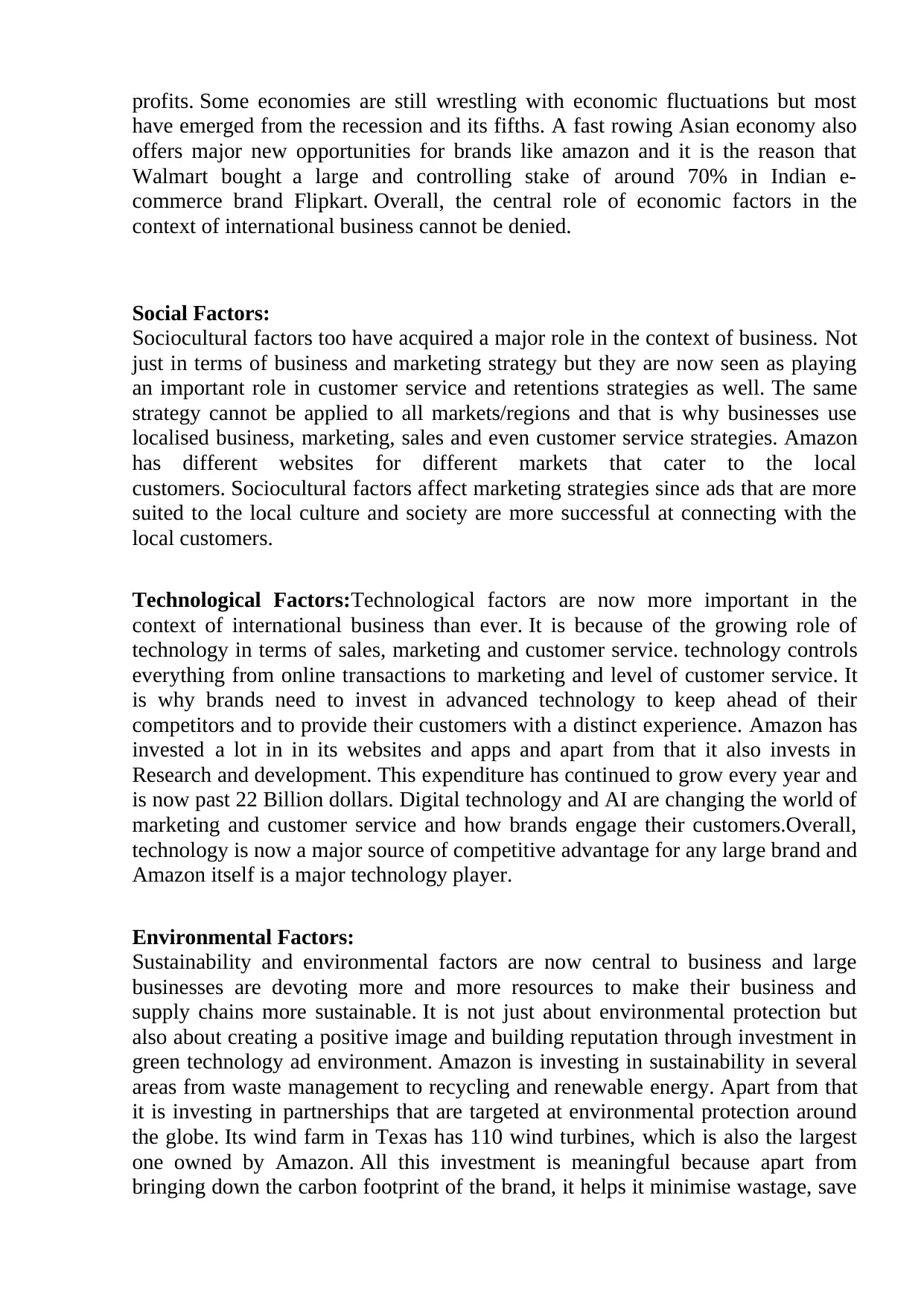
profits. Some economies are still wrestling with economic fluctuations but most
have emerged from the recession and its fifths. A fast rowing Asian economy also
offers major new opportunities for brands like amazon and it is the reason that
Walmart bought a large and controlling stake of around 70% in Indian e-
commerce brand Flipkart. Overall, the central role of economic factors in the
context of international business cannot be denied.
Social Factors:
Sociocultural factors too have acquired a major role in the context of business. Not
just in terms of business and marketing strategy but they are now seen as playing
an important role in customer service and retentions strategies as well. The same
strategy cannot be applied to all markets/regions and that is why businesses use
localised business, marketing, sales and even customer service strategies. Amazon
has different websites for different markets that cater to the local
customers. Sociocultural factors affect marketing strategies since ads that are more
suited to the local culture and society are more successful at connecting with the
local customers.
Technological Factors:Technological factors are now more important in the
context of international business than ever. It is because of the growing role of
technology in terms of sales, marketing and customer service. technology controls
everything from online transactions to marketing and level of customer service. It
is why brands need to invest in advanced technology to keep ahead of their
competitors and to provide their customers with a distinct experience. Amazon has
invested a lot in in its websites and apps and apart from that it also invests in
Research and development. This expenditure has continued to grow every year and
is now past 22 Billion dollars. Digital technology and AI are changing the world of
marketing and customer service and how brands engage their customers.Overall,
technology is now a major source of competitive advantage for any large brand and
Amazon itself is a major technology player.
Environmental Factors:
Sustainability and environmental factors are now central to business and large
businesses are devoting more and more resources to make their business and
supply chains more sustainable. It is not just about environmental protection but
also about creating a positive image and building reputation through investment in
green technology ad environment. Amazon is investing in sustainability in several
areas from waste management to recycling and renewable energy. Apart from that
it is investing in partnerships that are targeted at environmental protection around
the globe. Its wind farm in Texas has 110 wind turbines, which is also the largest
one owned by Amazon. All this investment is meaningful because apart from
bringing down the carbon footprint of the brand, it helps it minimise wastage, save
have emerged from the recession and its fifths. A fast rowing Asian economy also
offers major new opportunities for brands like amazon and it is the reason that
Walmart bought a large and controlling stake of around 70% in Indian e-
commerce brand Flipkart. Overall, the central role of economic factors in the
context of international business cannot be denied.
Social Factors:
Sociocultural factors too have acquired a major role in the context of business. Not
just in terms of business and marketing strategy but they are now seen as playing
an important role in customer service and retentions strategies as well. The same
strategy cannot be applied to all markets/regions and that is why businesses use
localised business, marketing, sales and even customer service strategies. Amazon
has different websites for different markets that cater to the local
customers. Sociocultural factors affect marketing strategies since ads that are more
suited to the local culture and society are more successful at connecting with the
local customers.
Technological Factors:Technological factors are now more important in the
context of international business than ever. It is because of the growing role of
technology in terms of sales, marketing and customer service. technology controls
everything from online transactions to marketing and level of customer service. It
is why brands need to invest in advanced technology to keep ahead of their
competitors and to provide their customers with a distinct experience. Amazon has
invested a lot in in its websites and apps and apart from that it also invests in
Research and development. This expenditure has continued to grow every year and
is now past 22 Billion dollars. Digital technology and AI are changing the world of
marketing and customer service and how brands engage their customers.Overall,
technology is now a major source of competitive advantage for any large brand and
Amazon itself is a major technology player.
Environmental Factors:
Sustainability and environmental factors are now central to business and large
businesses are devoting more and more resources to make their business and
supply chains more sustainable. It is not just about environmental protection but
also about creating a positive image and building reputation through investment in
green technology ad environment. Amazon is investing in sustainability in several
areas from waste management to recycling and renewable energy. Apart from that
it is investing in partnerships that are targeted at environmental protection around
the globe. Its wind farm in Texas has 110 wind turbines, which is also the largest
one owned by Amazon. All this investment is meaningful because apart from
bringing down the carbon footprint of the brand, it helps it minimise wastage, save
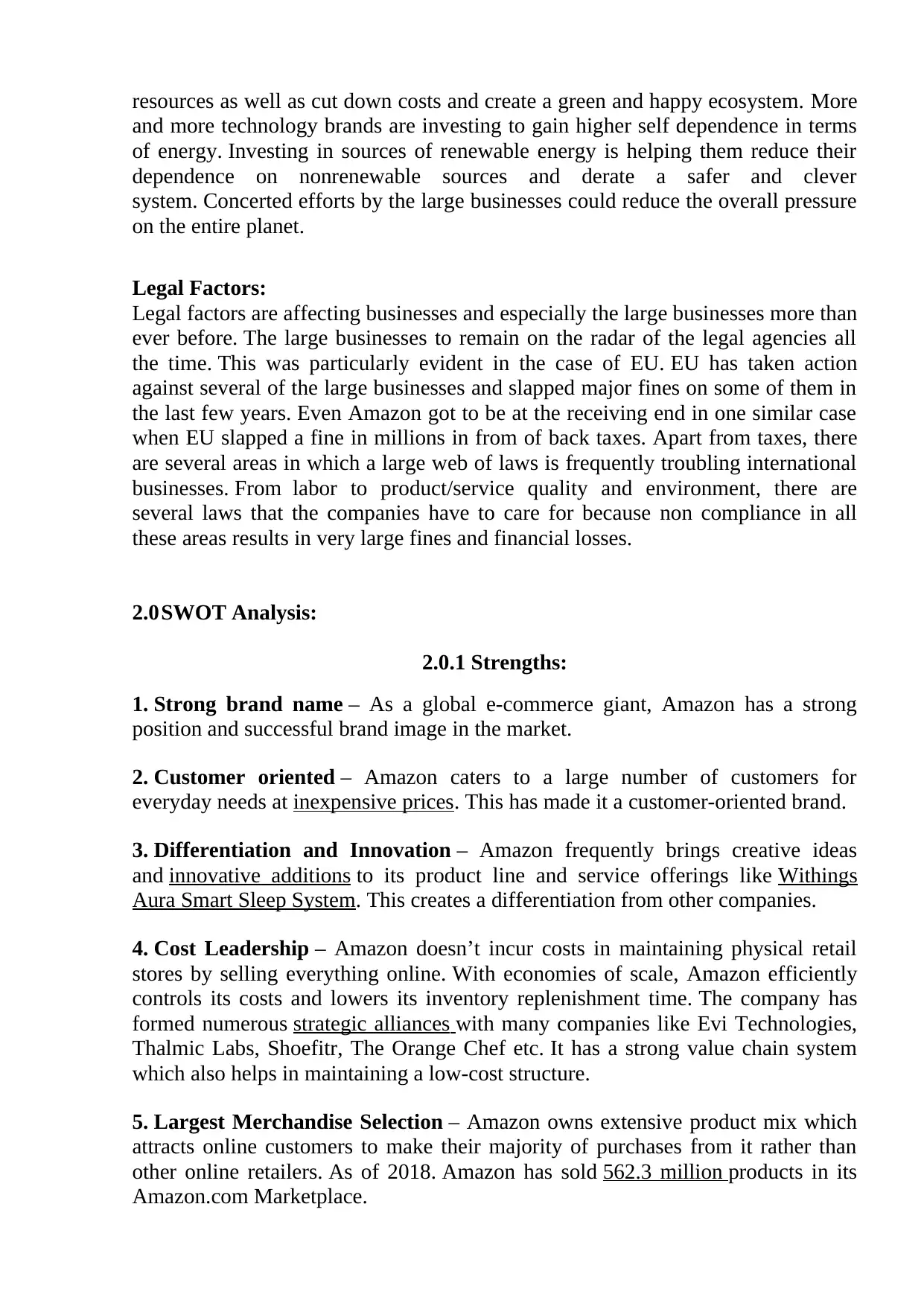
resources as well as cut down costs and create a green and happy ecosystem. More
and more technology brands are investing to gain higher self dependence in terms
of energy. Investing in sources of renewable energy is helping them reduce their
dependence on nonrenewable sources and derate a safer and clever
system. Concerted efforts by the large businesses could reduce the overall pressure
on the entire planet.
Legal Factors:
Legal factors are affecting businesses and especially the large businesses more than
ever before. The large businesses to remain on the radar of the legal agencies all
the time. This was particularly evident in the case of EU. EU has taken action
against several of the large businesses and slapped major fines on some of them in
the last few years. Even Amazon got to be at the receiving end in one similar case
when EU slapped a fine in millions in from of back taxes. Apart from taxes, there
are several areas in which a large web of laws is frequently troubling international
businesses. From labor to product/service quality and environment, there are
several laws that the companies have to care for because non compliance in all
these areas results in very large fines and financial losses.
2.0SWOT Analysis:
2.0.1 Strengths:
1. Strong brand name – As a global e-commerce giant, Amazon has a strong
position and successful brand image in the market.
2. Customer oriented – Amazon caters to a large number of customers for
everyday needs at inexpensive prices. This has made it a customer-oriented brand.
3. Differentiation and Innovation – Amazon frequently brings creative ideas
and innovative additions to its product line and service offerings like Withings
Aura Smart Sleep System. This creates a differentiation from other companies.
4. Cost Leadership – Amazon doesn’t incur costs in maintaining physical retail
stores by selling everything online. With economies of scale, Amazon efficiently
controls its costs and lowers its inventory replenishment time. The company has
formed numerous strategic alliances with many companies like Evi Technologies,
Thalmic Labs, Shoefitr, The Orange Chef etc. It has a strong value chain system
which also helps in maintaining a low-cost structure.
5. Largest Merchandise Selection – Amazon owns extensive product mix which
attracts online customers to make their majority of purchases from it rather than
other online retailers. As of 2018. Amazon has sold 562.3 million products in its
Amazon.com Marketplace.
and more technology brands are investing to gain higher self dependence in terms
of energy. Investing in sources of renewable energy is helping them reduce their
dependence on nonrenewable sources and derate a safer and clever
system. Concerted efforts by the large businesses could reduce the overall pressure
on the entire planet.
Legal Factors:
Legal factors are affecting businesses and especially the large businesses more than
ever before. The large businesses to remain on the radar of the legal agencies all
the time. This was particularly evident in the case of EU. EU has taken action
against several of the large businesses and slapped major fines on some of them in
the last few years. Even Amazon got to be at the receiving end in one similar case
when EU slapped a fine in millions in from of back taxes. Apart from taxes, there
are several areas in which a large web of laws is frequently troubling international
businesses. From labor to product/service quality and environment, there are
several laws that the companies have to care for because non compliance in all
these areas results in very large fines and financial losses.
2.0SWOT Analysis:
2.0.1 Strengths:
1. Strong brand name – As a global e-commerce giant, Amazon has a strong
position and successful brand image in the market.
2. Customer oriented – Amazon caters to a large number of customers for
everyday needs at inexpensive prices. This has made it a customer-oriented brand.
3. Differentiation and Innovation – Amazon frequently brings creative ideas
and innovative additions to its product line and service offerings like Withings
Aura Smart Sleep System. This creates a differentiation from other companies.
4. Cost Leadership – Amazon doesn’t incur costs in maintaining physical retail
stores by selling everything online. With economies of scale, Amazon efficiently
controls its costs and lowers its inventory replenishment time. The company has
formed numerous strategic alliances with many companies like Evi Technologies,
Thalmic Labs, Shoefitr, The Orange Chef etc. It has a strong value chain system
which also helps in maintaining a low-cost structure.
5. Largest Merchandise Selection – Amazon owns extensive product mix which
attracts online customers to make their majority of purchases from it rather than
other online retailers. As of 2018. Amazon has sold 562.3 million products in its
Amazon.com Marketplace.
Paraphrase This Document
Need a fresh take? Get an instant paraphrase of this document with our AI Paraphraser
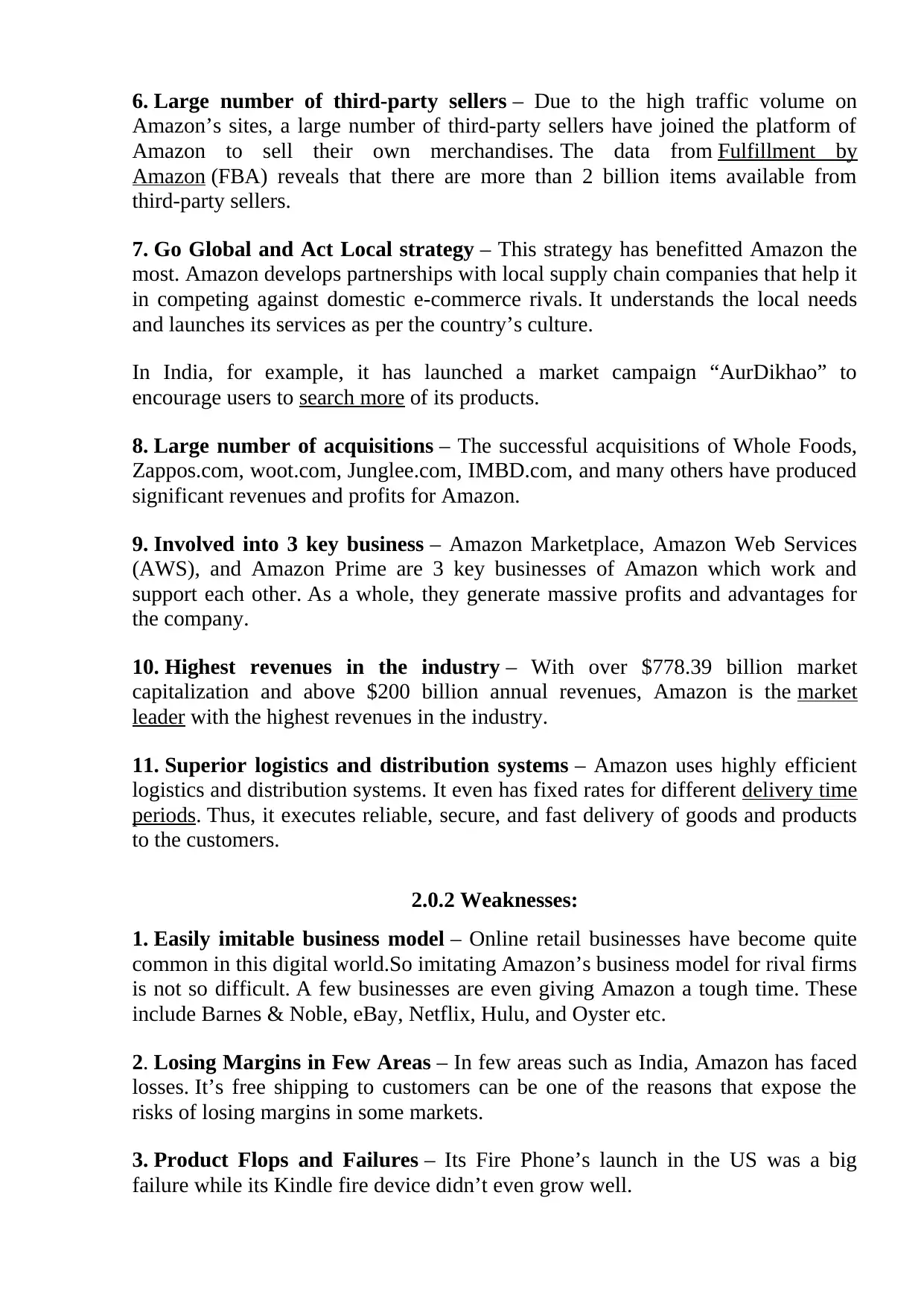
6. Large number of third-party sellers – Due to the high traffic volume on
Amazon’s sites, a large number of third-party sellers have joined the platform of
Amazon to sell their own merchandises. The data from Fulfillment by
Amazon (FBA) reveals that there are more than 2 billion items available from
third-party sellers.
7. Go Global and Act Local strategy – This strategy has benefitted Amazon the
most. Amazon develops partnerships with local supply chain companies that help it
in competing against domestic e-commerce rivals. It understands the local needs
and launches its services as per the country’s culture.
In India, for example, it has launched a market campaign “AurDikhao” to
encourage users to search more of its products.
8. Large number of acquisitions – The successful acquisitions of Whole Foods,
Zappos.com, woot.com, Junglee.com, IMBD.com, and many others have produced
significant revenues and profits for Amazon.
9. Involved into 3 key business – Amazon Marketplace, Amazon Web Services
(AWS), and Amazon Prime are 3 key businesses of Amazon which work and
support each other. As a whole, they generate massive profits and advantages for
the company.
10. Highest revenues in the industry – With over $778.39 billion market
capitalization and above $200 billion annual revenues, Amazon is the market
leader with the highest revenues in the industry.
11. Superior logistics and distribution systems – Amazon uses highly efficient
logistics and distribution systems. It even has fixed rates for different delivery time
periods. Thus, it executes reliable, secure, and fast delivery of goods and products
to the customers.
2.0.2 Weaknesses:
1. Easily imitable business model – Online retail businesses have become quite
common in this digital world.So imitating Amazon’s business model for rival firms
is not so difficult. A few businesses are even giving Amazon a tough time. These
include Barnes & Noble, eBay, Netflix, Hulu, and Oyster etc.
2. Losing Margins in Few Areas – In few areas such as India, Amazon has faced
losses. It’s free shipping to customers can be one of the reasons that expose the
risks of losing margins in some markets.
3. Product Flops and Failures – Its Fire Phone’s launch in the US was a big
failure while its Kindle fire device didn’t even grow well.
Amazon’s sites, a large number of third-party sellers have joined the platform of
Amazon to sell their own merchandises. The data from Fulfillment by
Amazon (FBA) reveals that there are more than 2 billion items available from
third-party sellers.
7. Go Global and Act Local strategy – This strategy has benefitted Amazon the
most. Amazon develops partnerships with local supply chain companies that help it
in competing against domestic e-commerce rivals. It understands the local needs
and launches its services as per the country’s culture.
In India, for example, it has launched a market campaign “AurDikhao” to
encourage users to search more of its products.
8. Large number of acquisitions – The successful acquisitions of Whole Foods,
Zappos.com, woot.com, Junglee.com, IMBD.com, and many others have produced
significant revenues and profits for Amazon.
9. Involved into 3 key business – Amazon Marketplace, Amazon Web Services
(AWS), and Amazon Prime are 3 key businesses of Amazon which work and
support each other. As a whole, they generate massive profits and advantages for
the company.
10. Highest revenues in the industry – With over $778.39 billion market
capitalization and above $200 billion annual revenues, Amazon is the market
leader with the highest revenues in the industry.
11. Superior logistics and distribution systems – Amazon uses highly efficient
logistics and distribution systems. It even has fixed rates for different delivery time
periods. Thus, it executes reliable, secure, and fast delivery of goods and products
to the customers.
2.0.2 Weaknesses:
1. Easily imitable business model – Online retail businesses have become quite
common in this digital world.So imitating Amazon’s business model for rival firms
is not so difficult. A few businesses are even giving Amazon a tough time. These
include Barnes & Noble, eBay, Netflix, Hulu, and Oyster etc.
2. Losing Margins in Few Areas – In few areas such as India, Amazon has faced
losses. It’s free shipping to customers can be one of the reasons that expose the
risks of losing margins in some markets.
3. Product Flops and Failures – Its Fire Phone’s launch in the US was a big
failure while its Kindle fire device didn’t even grow well.
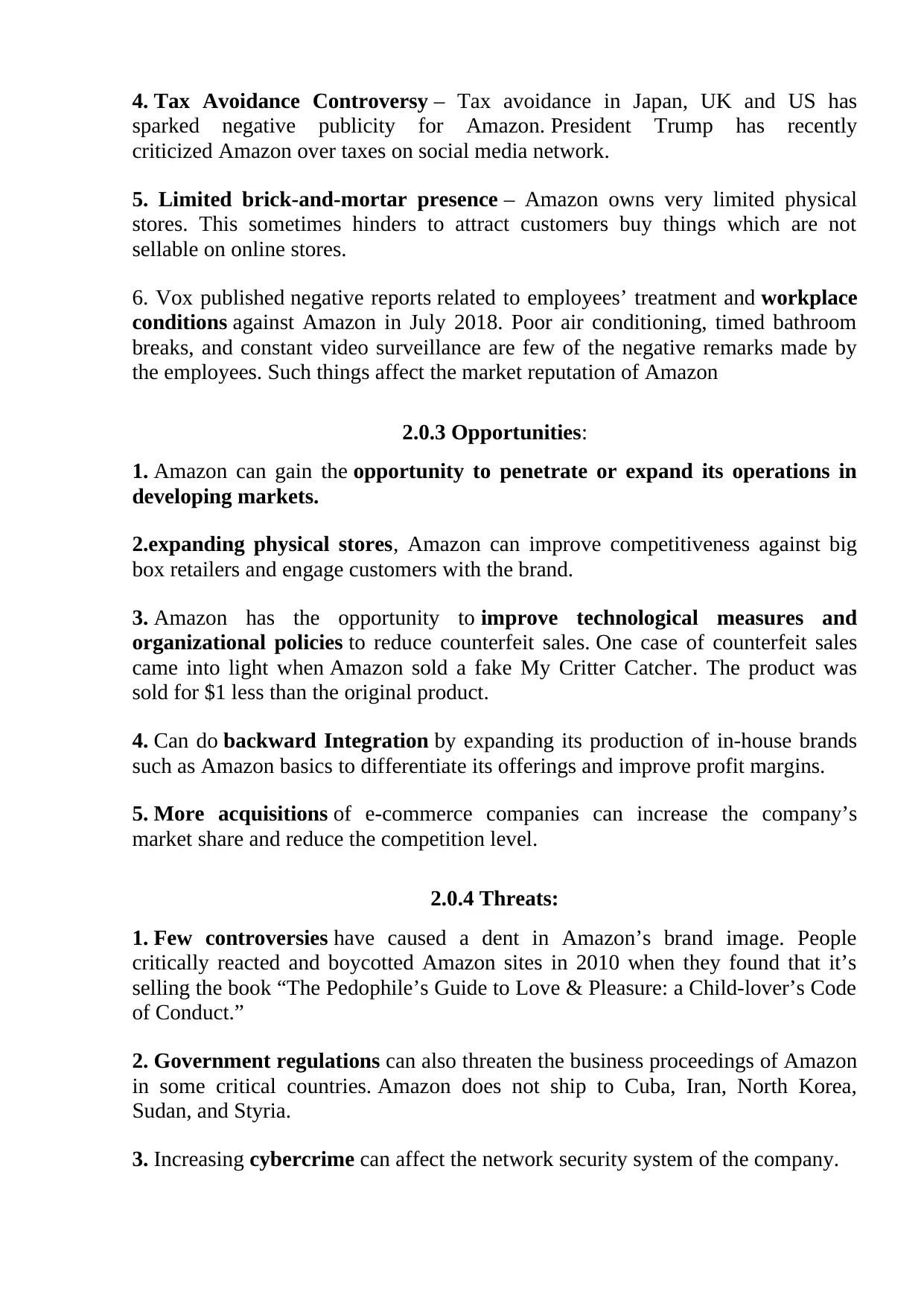
4. Tax Avoidance Controversy – Tax avoidance in Japan, UK and US has
sparked negative publicity for Amazon. President Trump has recently
criticized Amazon over taxes on social media network.
5. Limited brick-and-mortar presence – Amazon owns very limited physical
stores. This sometimes hinders to attract customers buy things which are not
sellable on online stores.
6. Vox published negative reports related to employees’ treatment and workplace
conditions against Amazon in July 2018. Poor air conditioning, timed bathroom
breaks, and constant video surveillance are few of the negative remarks made by
the employees. Such things affect the market reputation of Amazon
2.0.3 Opportunities:
1. Amazon can gain the opportunity to penetrate or expand its operations in
developing markets.
2.expanding physical stores, Amazon can improve competitiveness against big
box retailers and engage customers with the brand.
3. Amazon has the opportunity to improve technological measures and
organizational policies to reduce counterfeit sales. One case of counterfeit sales
came into light when Amazon sold a fake My Critter Catcher. The product was
sold for $1 less than the original product.
4. Can do backward Integration by expanding its production of in-house brands
such as Amazon basics to differentiate its offerings and improve profit margins.
5. More acquisitions of e-commerce companies can increase the company’s
market share and reduce the competition level.
2.0.4 Threats:
1. Few controversies have caused a dent in Amazon’s brand image. People
critically reacted and boycotted Amazon sites in 2010 when they found that it’s
selling the book “The Pedophile’s Guide to Love & Pleasure: a Child-lover’s Code
of Conduct.”
2. Government regulations can also threaten the business proceedings of Amazon
in some critical countries. Amazon does not ship to Cuba, Iran, North Korea,
Sudan, and Styria.
3. Increasing cybercrime can affect the network security system of the company.
sparked negative publicity for Amazon. President Trump has recently
criticized Amazon over taxes on social media network.
5. Limited brick-and-mortar presence – Amazon owns very limited physical
stores. This sometimes hinders to attract customers buy things which are not
sellable on online stores.
6. Vox published negative reports related to employees’ treatment and workplace
conditions against Amazon in July 2018. Poor air conditioning, timed bathroom
breaks, and constant video surveillance are few of the negative remarks made by
the employees. Such things affect the market reputation of Amazon
2.0.3 Opportunities:
1. Amazon can gain the opportunity to penetrate or expand its operations in
developing markets.
2.expanding physical stores, Amazon can improve competitiveness against big
box retailers and engage customers with the brand.
3. Amazon has the opportunity to improve technological measures and
organizational policies to reduce counterfeit sales. One case of counterfeit sales
came into light when Amazon sold a fake My Critter Catcher. The product was
sold for $1 less than the original product.
4. Can do backward Integration by expanding its production of in-house brands
such as Amazon basics to differentiate its offerings and improve profit margins.
5. More acquisitions of e-commerce companies can increase the company’s
market share and reduce the competition level.
2.0.4 Threats:
1. Few controversies have caused a dent in Amazon’s brand image. People
critically reacted and boycotted Amazon sites in 2010 when they found that it’s
selling the book “The Pedophile’s Guide to Love & Pleasure: a Child-lover’s Code
of Conduct.”
2. Government regulations can also threaten the business proceedings of Amazon
in some critical countries. Amazon does not ship to Cuba, Iran, North Korea,
Sudan, and Styria.
3. Increasing cybercrime can affect the network security system of the company.

4. Aggressive competition with big retail firms like Walmart and eBay can give
Amazon a tough time in the future.
5. Imitation is easy as many new entrants are coming up in the market usually
with the same business model of Amazon.
2.1Analysis of the Competition
The strongest competitors of Amazon:
1. eBay
2. Walmart
3. Home Depot
4. Etsy
5. Best Buy
6. Flipkart
7. Kroger
8. Target
9. Netflix
10.Microsoft Azure
11.Facebook
12.FedEx
13.Alibaba
14.JD.com
Amazon E-commerce Competitors
In the e-commerce segmentEbayis the top competitor of Amazon. eBay Inc. is an
e-commerce marketplace founded in 1995 by Pierre Omidyar headquartered in San
Jose, California. The companywebsite engages both business-to-business and
business-to-consumer sales. After its humble beginning, eBay turned into a
household name. It is “the online marketplace” where individuals and businesses
buy and sell variety of goods. Buyers can freely use website but sellers are charged
fee for their items sold after providing limited free listings. Countless transactions
go through eBay website on daily basis. After Amazon, eBay is the second largest
e-commerce company in the United States in sales share at 6.1%.
Walmart is one of the fastest growing ecommerce retailer in 2019. This retail
giant surpassed Apple to become the third largest e-commerce retailer. Walmart e-
commerce sales up 43% in Q4 of 2018 in the US market. This was made possible
due to growing online grocery, delivery business and huge collection of
assortments on Walmart.com. Walmart has become the strongest competitor of
Amazon, Instacart and many other grocery businesses. Wal-mart.com is working
Amazon a tough time in the future.
5. Imitation is easy as many new entrants are coming up in the market usually
with the same business model of Amazon.
2.1Analysis of the Competition
The strongest competitors of Amazon:
1. eBay
2. Walmart
3. Home Depot
4. Etsy
5. Best Buy
6. Flipkart
7. Kroger
8. Target
9. Netflix
10.Microsoft Azure
11.Facebook
12.FedEx
13.Alibaba
14.JD.com
Amazon E-commerce Competitors
In the e-commerce segmentEbayis the top competitor of Amazon. eBay Inc. is an
e-commerce marketplace founded in 1995 by Pierre Omidyar headquartered in San
Jose, California. The companywebsite engages both business-to-business and
business-to-consumer sales. After its humble beginning, eBay turned into a
household name. It is “the online marketplace” where individuals and businesses
buy and sell variety of goods. Buyers can freely use website but sellers are charged
fee for their items sold after providing limited free listings. Countless transactions
go through eBay website on daily basis. After Amazon, eBay is the second largest
e-commerce company in the United States in sales share at 6.1%.
Walmart is one of the fastest growing ecommerce retailer in 2019. This retail
giant surpassed Apple to become the third largest e-commerce retailer. Walmart e-
commerce sales up 43% in Q4 of 2018 in the US market. This was made possible
due to growing online grocery, delivery business and huge collection of
assortments on Walmart.com. Walmart has become the strongest competitor of
Amazon, Instacart and many other grocery businesses. Wal-mart.com is working
Secure Best Marks with AI Grader
Need help grading? Try our AI Grader for instant feedback on your assignments.
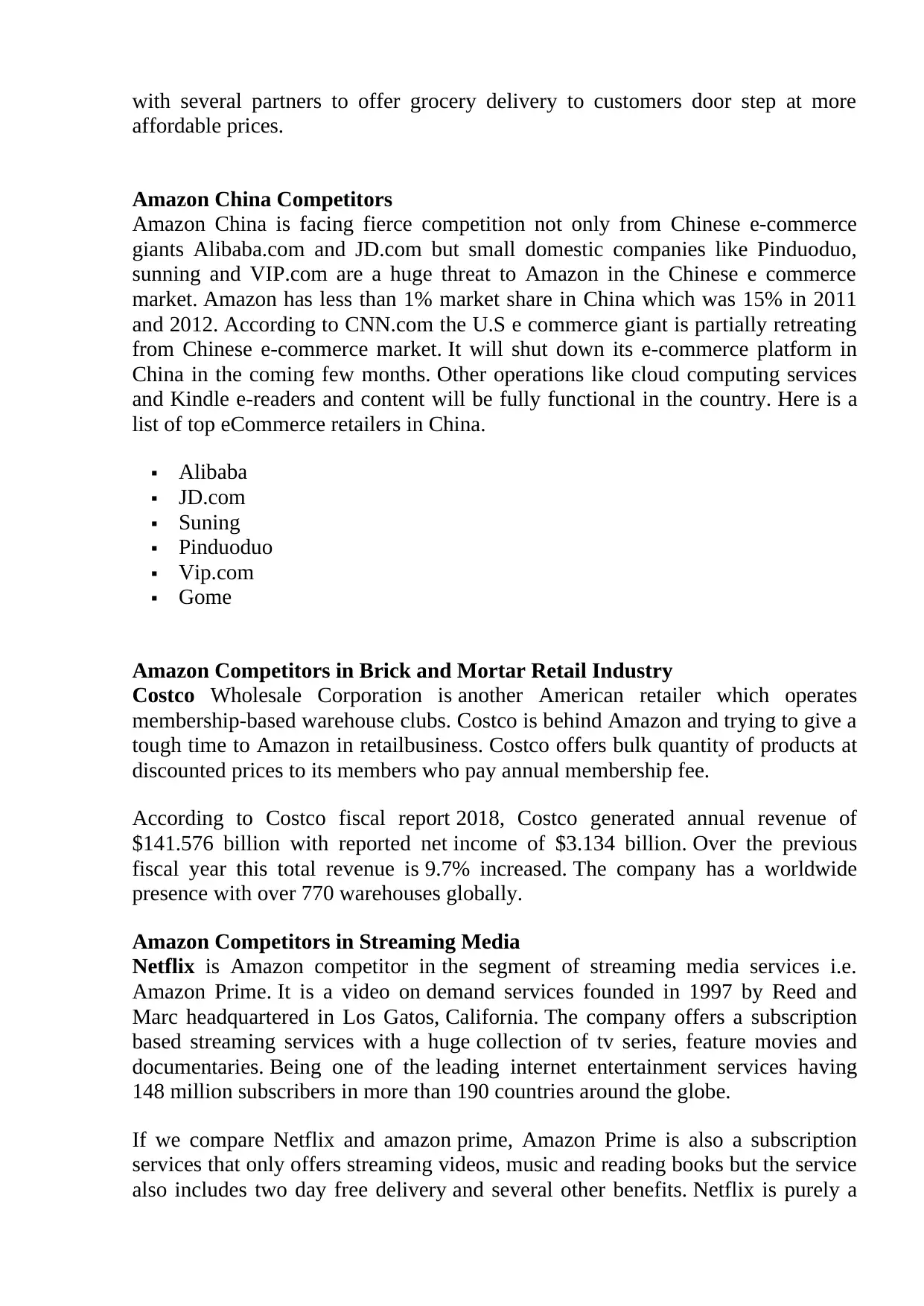
with several partners to offer grocery delivery to customers door step at more
affordable prices.
Amazon China Competitors
Amazon China is facing fierce competition not only from Chinese e-commerce
giants Alibaba.com and JD.com but small domestic companies like Pinduoduo,
sunning and VIP.com are a huge threat to Amazon in the Chinese e commerce
market. Amazon has less than 1% market share in China which was 15% in 2011
and 2012. According to CNN.com the U.S e commerce giant is partially retreating
from Chinese e-commerce market. It will shut down its e-commerce platform in
China in the coming few months. Other operations like cloud computing services
and Kindle e-readers and content will be fully functional in the country. Here is a
list of top eCommerce retailers in China.
Alibaba
JD.com
Suning
Pinduoduo
Vip.com
Gome
Amazon Competitors in Brick and Mortar Retail Industry
Costco Wholesale Corporation is another American retailer which operates
membership-based warehouse clubs. Costco is behind Amazon and trying to give a
tough time to Amazon in retailbusiness. Costco offers bulk quantity of products at
discounted prices to its members who pay annual membership fee.
According to Costco fiscal report 2018, Costco generated annual revenue of
$141.576 billion with reported net income of $3.134 billion. Over the previous
fiscal year this total revenue is 9.7% increased. The company has a worldwide
presence with over 770 warehouses globally.
Amazon Competitors in Streaming Media
Netflix is Amazon competitor in the segment of streaming media services i.e.
Amazon Prime. It is a video on demand services founded in 1997 by Reed and
Marc headquartered in Los Gatos, California. The company offers a subscription
based streaming services with a huge collection of tv series, feature movies and
documentaries. Being one of the leading internet entertainment services having
148 million subscribers in more than 190 countries around the globe.
If we compare Netflix and amazon prime, Amazon Prime is also a subscription
services that only offers streaming videos, music and reading books but the service
also includes two day free delivery and several other benefits. Netflix is purely a
affordable prices.
Amazon China Competitors
Amazon China is facing fierce competition not only from Chinese e-commerce
giants Alibaba.com and JD.com but small domestic companies like Pinduoduo,
sunning and VIP.com are a huge threat to Amazon in the Chinese e commerce
market. Amazon has less than 1% market share in China which was 15% in 2011
and 2012. According to CNN.com the U.S e commerce giant is partially retreating
from Chinese e-commerce market. It will shut down its e-commerce platform in
China in the coming few months. Other operations like cloud computing services
and Kindle e-readers and content will be fully functional in the country. Here is a
list of top eCommerce retailers in China.
Alibaba
JD.com
Suning
Pinduoduo
Vip.com
Gome
Amazon Competitors in Brick and Mortar Retail Industry
Costco Wholesale Corporation is another American retailer which operates
membership-based warehouse clubs. Costco is behind Amazon and trying to give a
tough time to Amazon in retailbusiness. Costco offers bulk quantity of products at
discounted prices to its members who pay annual membership fee.
According to Costco fiscal report 2018, Costco generated annual revenue of
$141.576 billion with reported net income of $3.134 billion. Over the previous
fiscal year this total revenue is 9.7% increased. The company has a worldwide
presence with over 770 warehouses globally.
Amazon Competitors in Streaming Media
Netflix is Amazon competitor in the segment of streaming media services i.e.
Amazon Prime. It is a video on demand services founded in 1997 by Reed and
Marc headquartered in Los Gatos, California. The company offers a subscription
based streaming services with a huge collection of tv series, feature movies and
documentaries. Being one of the leading internet entertainment services having
148 million subscribers in more than 190 countries around the globe.
If we compare Netflix and amazon prime, Amazon Prime is also a subscription
services that only offers streaming videos, music and reading books but the service
also includes two day free delivery and several other benefits. Netflix is purely a
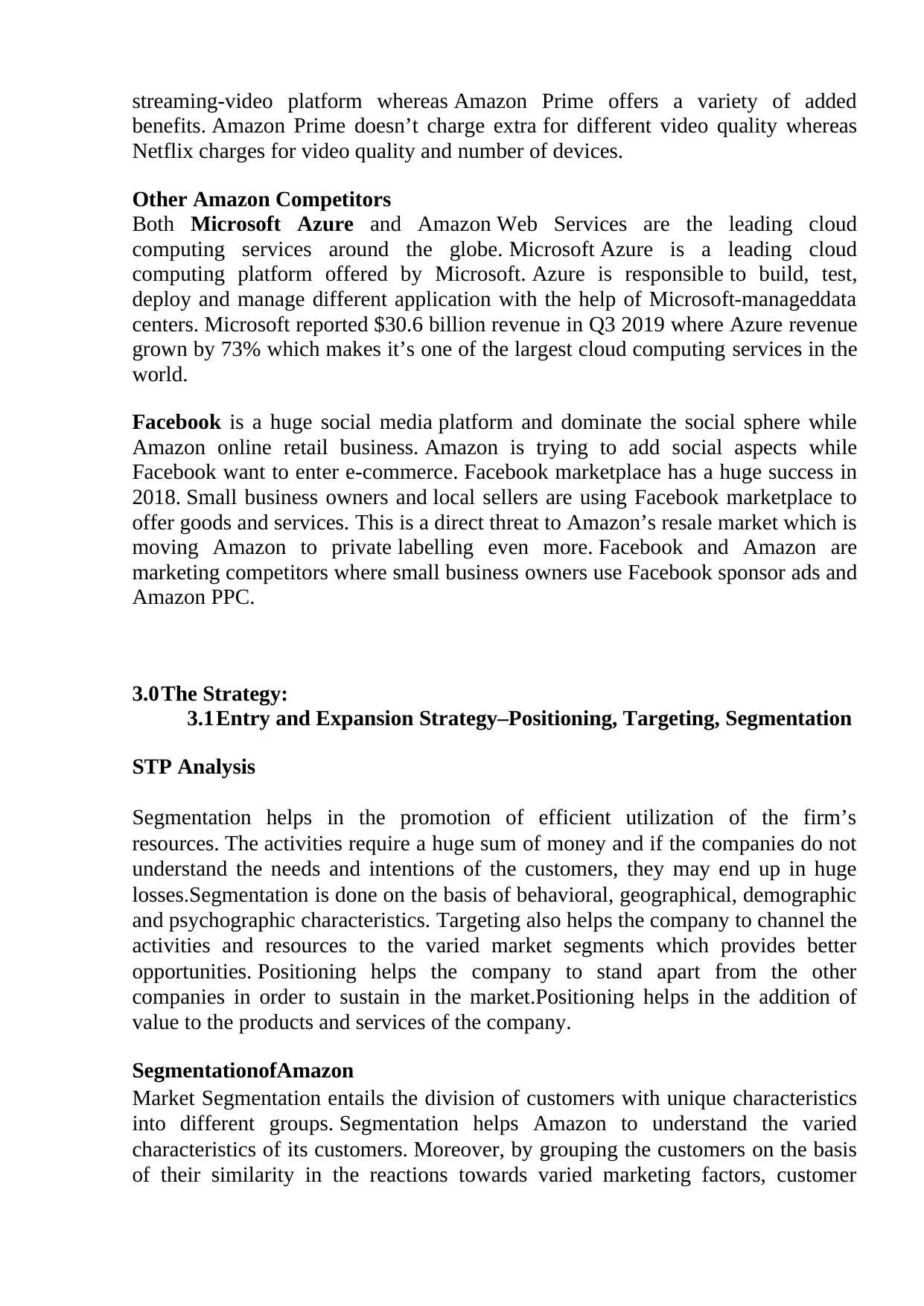
streaming-video platform whereas Amazon Prime offers a variety of added
benefits. Amazon Prime doesn’t charge extra for different video quality whereas
Netflix charges for video quality and number of devices.
Other Amazon Competitors
Both Microsoft Azure and Amazon Web Services are the leading cloud
computing services around the globe. Microsoft Azure is a leading cloud
computing platform offered by Microsoft. Azure is responsible to build, test,
deploy and manage different application with the help of Microsoft-manageddata
centers. Microsoft reported $30.6 billion revenue in Q3 2019 where Azure revenue
grown by 73% which makes it’s one of the largest cloud computing services in the
world.
Facebook is a huge social media platform and dominate the social sphere while
Amazon online retail business. Amazon is trying to add social aspects while
Facebook want to enter e-commerce. Facebook marketplace has a huge success in
2018. Small business owners and local sellers are using Facebook marketplace to
offer goods and services. This is a direct threat to Amazon’s resale market which is
moving Amazon to private labelling even more. Facebook and Amazon are
marketing competitors where small business owners use Facebook sponsor ads and
Amazon PPC.
3.0The Strategy:
3.1Entry and Expansion Strategy–Positioning, Targeting, Segmentation
STP Analysis
Segmentation helps in the promotion of efficient utilization of the firm’s
resources. The activities require a huge sum of money and if the companies do not
understand the needs and intentions of the customers, they may end up in huge
losses.Segmentation is done on the basis of behavioral, geographical, demographic
and psychographic characteristics. Targeting also helps the company to channel the
activities and resources to the varied market segments which provides better
opportunities. Positioning helps the company to stand apart from the other
companies in order to sustain in the market.Positioning helps in the addition of
value to the products and services of the company.
SegmentationofAmazon
Market Segmentation entails the division of customers with unique characteristics
into different groups. Segmentation helps Amazon to understand the varied
characteristics of its customers. Moreover, by grouping the customers on the basis
of their similarity in the reactions towards varied marketing factors, customer
benefits. Amazon Prime doesn’t charge extra for different video quality whereas
Netflix charges for video quality and number of devices.
Other Amazon Competitors
Both Microsoft Azure and Amazon Web Services are the leading cloud
computing services around the globe. Microsoft Azure is a leading cloud
computing platform offered by Microsoft. Azure is responsible to build, test,
deploy and manage different application with the help of Microsoft-manageddata
centers. Microsoft reported $30.6 billion revenue in Q3 2019 where Azure revenue
grown by 73% which makes it’s one of the largest cloud computing services in the
world.
Facebook is a huge social media platform and dominate the social sphere while
Amazon online retail business. Amazon is trying to add social aspects while
Facebook want to enter e-commerce. Facebook marketplace has a huge success in
2018. Small business owners and local sellers are using Facebook marketplace to
offer goods and services. This is a direct threat to Amazon’s resale market which is
moving Amazon to private labelling even more. Facebook and Amazon are
marketing competitors where small business owners use Facebook sponsor ads and
Amazon PPC.
3.0The Strategy:
3.1Entry and Expansion Strategy–Positioning, Targeting, Segmentation
STP Analysis
Segmentation helps in the promotion of efficient utilization of the firm’s
resources. The activities require a huge sum of money and if the companies do not
understand the needs and intentions of the customers, they may end up in huge
losses.Segmentation is done on the basis of behavioral, geographical, demographic
and psychographic characteristics. Targeting also helps the company to channel the
activities and resources to the varied market segments which provides better
opportunities. Positioning helps the company to stand apart from the other
companies in order to sustain in the market.Positioning helps in the addition of
value to the products and services of the company.
SegmentationofAmazon
Market Segmentation entails the division of customers with unique characteristics
into different groups. Segmentation helps Amazon to understand the varied
characteristics of its customers. Moreover, by grouping the customers on the basis
of their similarity in the reactions towards varied marketing factors, customer
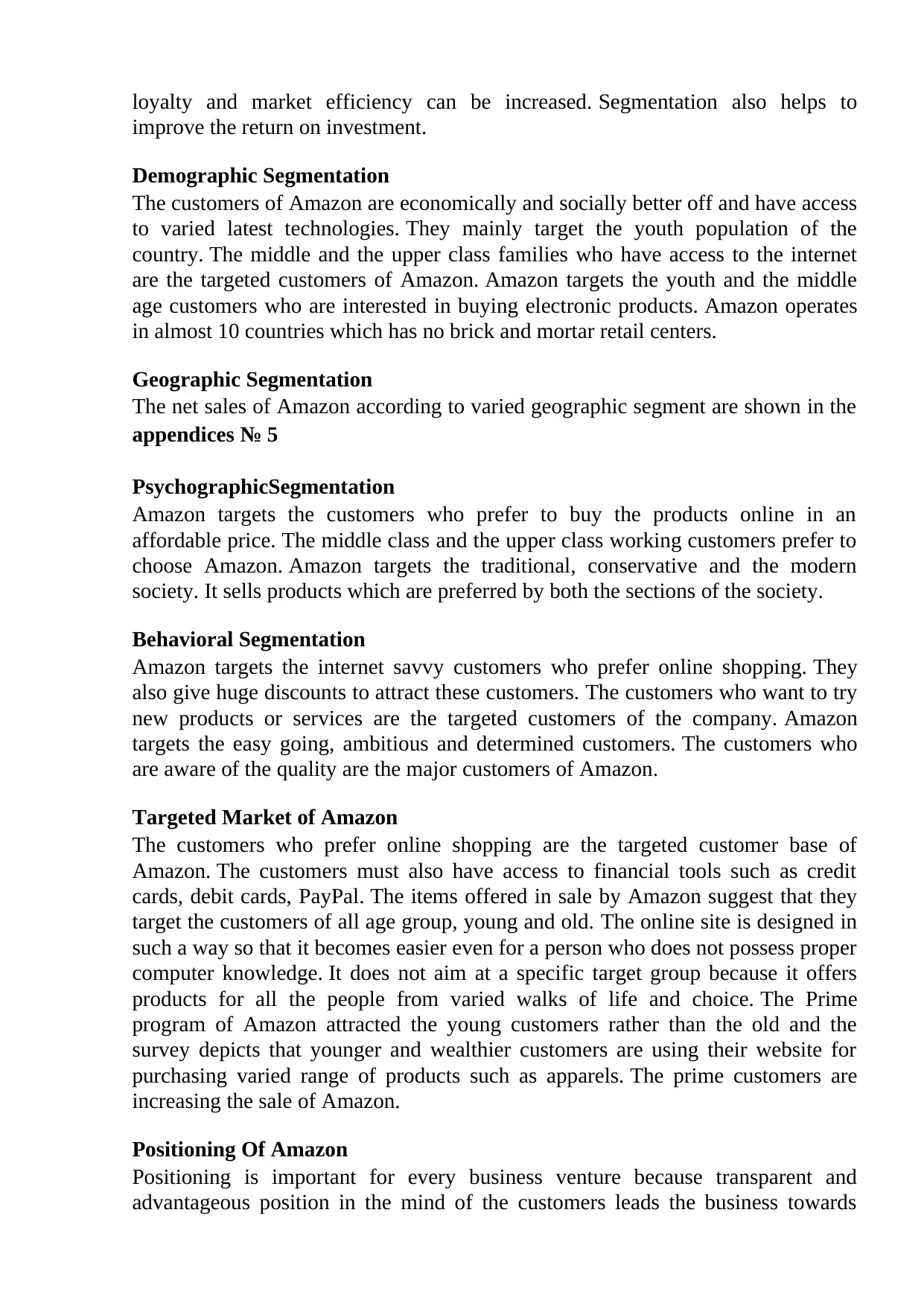
loyalty and market efficiency can be increased. Segmentation also helps to
improve the return on investment.
Demographic Segmentation
The customers of Amazon are economically and socially better off and have access
to varied latest technologies. They mainly target the youth population of the
country. The middle and the upper class families who have access to the internet
are the targeted customers of Amazon. Amazon targets the youth and the middle
age customers who are interested in buying electronic products. Amazon operates
in almost 10 countries which has no brick and mortar retail centers.
Geographic Segmentation
The net sales of Amazon according to varied geographic segment are shown in the
appendices № 5
PsychographicSegmentation
Amazon targets the customers who prefer to buy the products online in an
affordable price. The middle class and the upper class working customers prefer to
choose Amazon. Amazon targets the traditional, conservative and the modern
society. It sells products which are preferred by both the sections of the society.
Behavioral Segmentation
Amazon targets the internet savvy customers who prefer online shopping. They
also give huge discounts to attract these customers. The customers who want to try
new products or services are the targeted customers of the company. Amazon
targets the easy going, ambitious and determined customers. The customers who
are aware of the quality are the major customers of Amazon.
Targeted Market of Amazon
The customers who prefer online shopping are the targeted customer base of
Amazon. The customers must also have access to financial tools such as credit
cards, debit cards, PayPal. The items offered in sale by Amazon suggest that they
target the customers of all age group, young and old. The online site is designed in
such a way so that it becomes easier even for a person who does not possess proper
computer knowledge. It does not aim at a specific target group because it offers
products for all the people from varied walks of life and choice. The Prime
program of Amazon attracted the young customers rather than the old and the
survey depicts that younger and wealthier customers are using their website for
purchasing varied range of products such as apparels. The prime customers are
increasing the sale of Amazon.
Positioning Of Amazon
Positioning is important for every business venture because transparent and
advantageous position in the mind of the customers leads the business towards
improve the return on investment.
Demographic Segmentation
The customers of Amazon are economically and socially better off and have access
to varied latest technologies. They mainly target the youth population of the
country. The middle and the upper class families who have access to the internet
are the targeted customers of Amazon. Amazon targets the youth and the middle
age customers who are interested in buying electronic products. Amazon operates
in almost 10 countries which has no brick and mortar retail centers.
Geographic Segmentation
The net sales of Amazon according to varied geographic segment are shown in the
appendices № 5
PsychographicSegmentation
Amazon targets the customers who prefer to buy the products online in an
affordable price. The middle class and the upper class working customers prefer to
choose Amazon. Amazon targets the traditional, conservative and the modern
society. It sells products which are preferred by both the sections of the society.
Behavioral Segmentation
Amazon targets the internet savvy customers who prefer online shopping. They
also give huge discounts to attract these customers. The customers who want to try
new products or services are the targeted customers of the company. Amazon
targets the easy going, ambitious and determined customers. The customers who
are aware of the quality are the major customers of Amazon.
Targeted Market of Amazon
The customers who prefer online shopping are the targeted customer base of
Amazon. The customers must also have access to financial tools such as credit
cards, debit cards, PayPal. The items offered in sale by Amazon suggest that they
target the customers of all age group, young and old. The online site is designed in
such a way so that it becomes easier even for a person who does not possess proper
computer knowledge. It does not aim at a specific target group because it offers
products for all the people from varied walks of life and choice. The Prime
program of Amazon attracted the young customers rather than the old and the
survey depicts that younger and wealthier customers are using their website for
purchasing varied range of products such as apparels. The prime customers are
increasing the sale of Amazon.
Positioning Of Amazon
Positioning is important for every business venture because transparent and
advantageous position in the mind of the customers leads the business towards
Paraphrase This Document
Need a fresh take? Get an instant paraphrase of this document with our AI Paraphraser
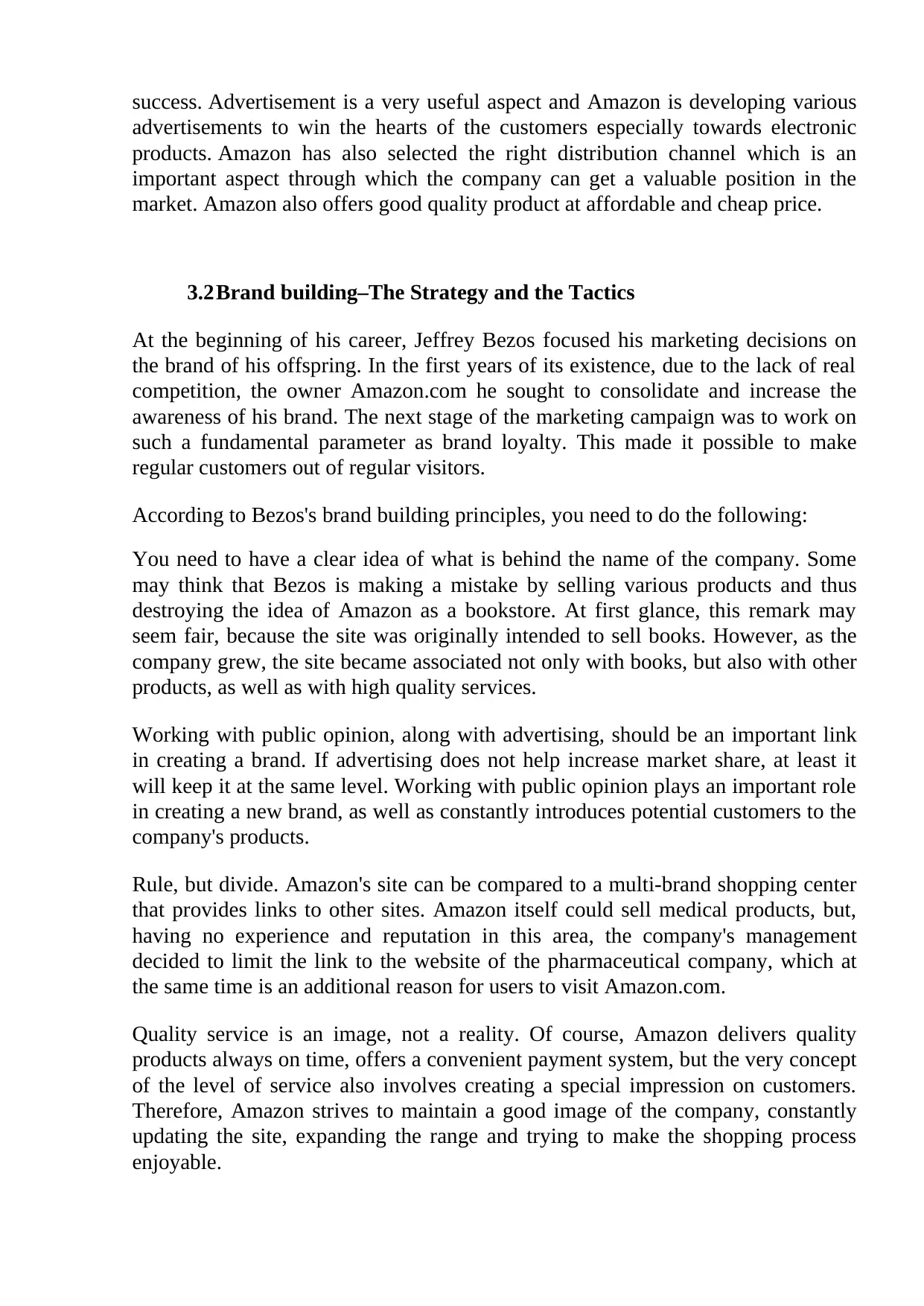
success. Advertisement is a very useful aspect and Amazon is developing various
advertisements to win the hearts of the customers especially towards electronic
products. Amazon has also selected the right distribution channel which is an
important aspect through which the company can get a valuable position in the
market. Amazon also offers good quality product at affordable and cheap price.
3.2Brand building–The Strategy and the Tactics
At the beginning of his career, Jeffrey Bezos focused his marketing decisions on
the brand of his offspring. In the first years of its existence, due to the lack of real
competition, the owner Amazon.com he sought to consolidate and increase the
awareness of his brand. The next stage of the marketing campaign was to work on
such a fundamental parameter as brand loyalty. This made it possible to make
regular customers out of regular visitors.
According to Bezos's brand building principles, you need to do the following:
You need to have a clear idea of what is behind the name of the company. Some
may think that Bezos is making a mistake by selling various products and thus
destroying the idea of Amazon as a bookstore. At first glance, this remark may
seem fair, because the site was originally intended to sell books. However, as the
company grew, the site became associated not only with books, but also with other
products, as well as with high quality services.
Working with public opinion, along with advertising, should be an important link
in creating a brand. If advertising does not help increase market share, at least it
will keep it at the same level. Working with public opinion plays an important role
in creating a new brand, as well as constantly introduces potential customers to the
company's products.
Rule, but divide. Amazon's site can be compared to a multi-brand shopping center
that provides links to other sites. Amazon itself could sell medical products, but,
having no experience and reputation in this area, the company's management
decided to limit the link to the website of the pharmaceutical company, which at
the same time is an additional reason for users to visit Amazon.com.
Quality service is an image, not a reality. Of course, Amazon delivers quality
products always on time, offers a convenient payment system, but the very concept
of the level of service also involves creating a special impression on customers.
Therefore, Amazon strives to maintain a good image of the company, constantly
updating the site, expanding the range and trying to make the shopping process
enjoyable.
advertisements to win the hearts of the customers especially towards electronic
products. Amazon has also selected the right distribution channel which is an
important aspect through which the company can get a valuable position in the
market. Amazon also offers good quality product at affordable and cheap price.
3.2Brand building–The Strategy and the Tactics
At the beginning of his career, Jeffrey Bezos focused his marketing decisions on
the brand of his offspring. In the first years of its existence, due to the lack of real
competition, the owner Amazon.com he sought to consolidate and increase the
awareness of his brand. The next stage of the marketing campaign was to work on
such a fundamental parameter as brand loyalty. This made it possible to make
regular customers out of regular visitors.
According to Bezos's brand building principles, you need to do the following:
You need to have a clear idea of what is behind the name of the company. Some
may think that Bezos is making a mistake by selling various products and thus
destroying the idea of Amazon as a bookstore. At first glance, this remark may
seem fair, because the site was originally intended to sell books. However, as the
company grew, the site became associated not only with books, but also with other
products, as well as with high quality services.
Working with public opinion, along with advertising, should be an important link
in creating a brand. If advertising does not help increase market share, at least it
will keep it at the same level. Working with public opinion plays an important role
in creating a new brand, as well as constantly introduces potential customers to the
company's products.
Rule, but divide. Amazon's site can be compared to a multi-brand shopping center
that provides links to other sites. Amazon itself could sell medical products, but,
having no experience and reputation in this area, the company's management
decided to limit the link to the website of the pharmaceutical company, which at
the same time is an additional reason for users to visit Amazon.com.
Quality service is an image, not a reality. Of course, Amazon delivers quality
products always on time, offers a convenient payment system, but the very concept
of the level of service also involves creating a special impression on customers.
Therefore, Amazon strives to maintain a good image of the company, constantly
updating the site, expanding the range and trying to make the shopping process
enjoyable.
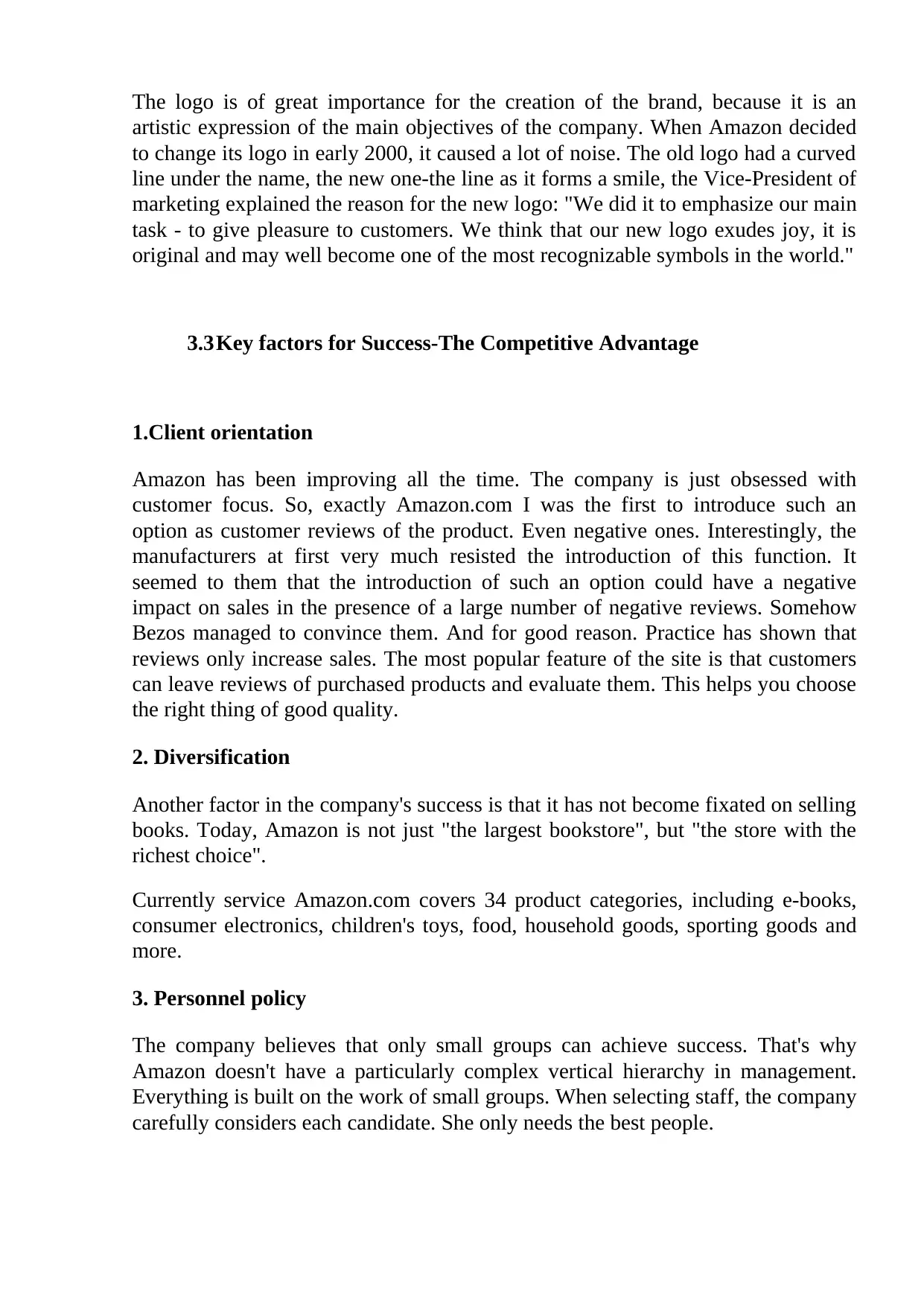
The logo is of great importance for the creation of the brand, because it is an
artistic expression of the main objectives of the company. When Amazon decided
to change its logo in early 2000, it caused a lot of noise. The old logo had a curved
line under the name, the new one-the line as it forms a smile, the Vice-President of
marketing explained the reason for the new logo: "We did it to emphasize our main
task - to give pleasure to customers. We think that our new logo exudes joy, it is
original and may well become one of the most recognizable symbols in the world."
3.3Key factors for Success-The Competitive Advantage
1.Client orientation
Amazon has been improving all the time. The company is just obsessed with
customer focus. So, exactly Amazon.com I was the first to introduce such an
option as customer reviews of the product. Even negative ones. Interestingly, the
manufacturers at first very much resisted the introduction of this function. It
seemed to them that the introduction of such an option could have a negative
impact on sales in the presence of a large number of negative reviews. Somehow
Bezos managed to convince them. And for good reason. Practice has shown that
reviews only increase sales. The most popular feature of the site is that customers
can leave reviews of purchased products and evaluate them. This helps you choose
the right thing of good quality.
2. Diversification
Another factor in the company's success is that it has not become fixated on selling
books. Today, Amazon is not just "the largest bookstore", but "the store with the
richest choice".
Currently service Amazon.com covers 34 product categories, including e-books,
consumer electronics, children's toys, food, household goods, sporting goods and
more.
3. Personnel policy
The company believes that only small groups can achieve success. That's why
Amazon doesn't have a particularly complex vertical hierarchy in management.
Everything is built on the work of small groups. When selecting staff, the company
carefully considers each candidate. She only needs the best people.
artistic expression of the main objectives of the company. When Amazon decided
to change its logo in early 2000, it caused a lot of noise. The old logo had a curved
line under the name, the new one-the line as it forms a smile, the Vice-President of
marketing explained the reason for the new logo: "We did it to emphasize our main
task - to give pleasure to customers. We think that our new logo exudes joy, it is
original and may well become one of the most recognizable symbols in the world."
3.3Key factors for Success-The Competitive Advantage
1.Client orientation
Amazon has been improving all the time. The company is just obsessed with
customer focus. So, exactly Amazon.com I was the first to introduce such an
option as customer reviews of the product. Even negative ones. Interestingly, the
manufacturers at first very much resisted the introduction of this function. It
seemed to them that the introduction of such an option could have a negative
impact on sales in the presence of a large number of negative reviews. Somehow
Bezos managed to convince them. And for good reason. Practice has shown that
reviews only increase sales. The most popular feature of the site is that customers
can leave reviews of purchased products and evaluate them. This helps you choose
the right thing of good quality.
2. Diversification
Another factor in the company's success is that it has not become fixated on selling
books. Today, Amazon is not just "the largest bookstore", but "the store with the
richest choice".
Currently service Amazon.com covers 34 product categories, including e-books,
consumer electronics, children's toys, food, household goods, sporting goods and
more.
3. Personnel policy
The company believes that only small groups can achieve success. That's why
Amazon doesn't have a particularly complex vertical hierarchy in management.
Everything is built on the work of small groups. When selecting staff, the company
carefully considers each candidate. She only needs the best people.
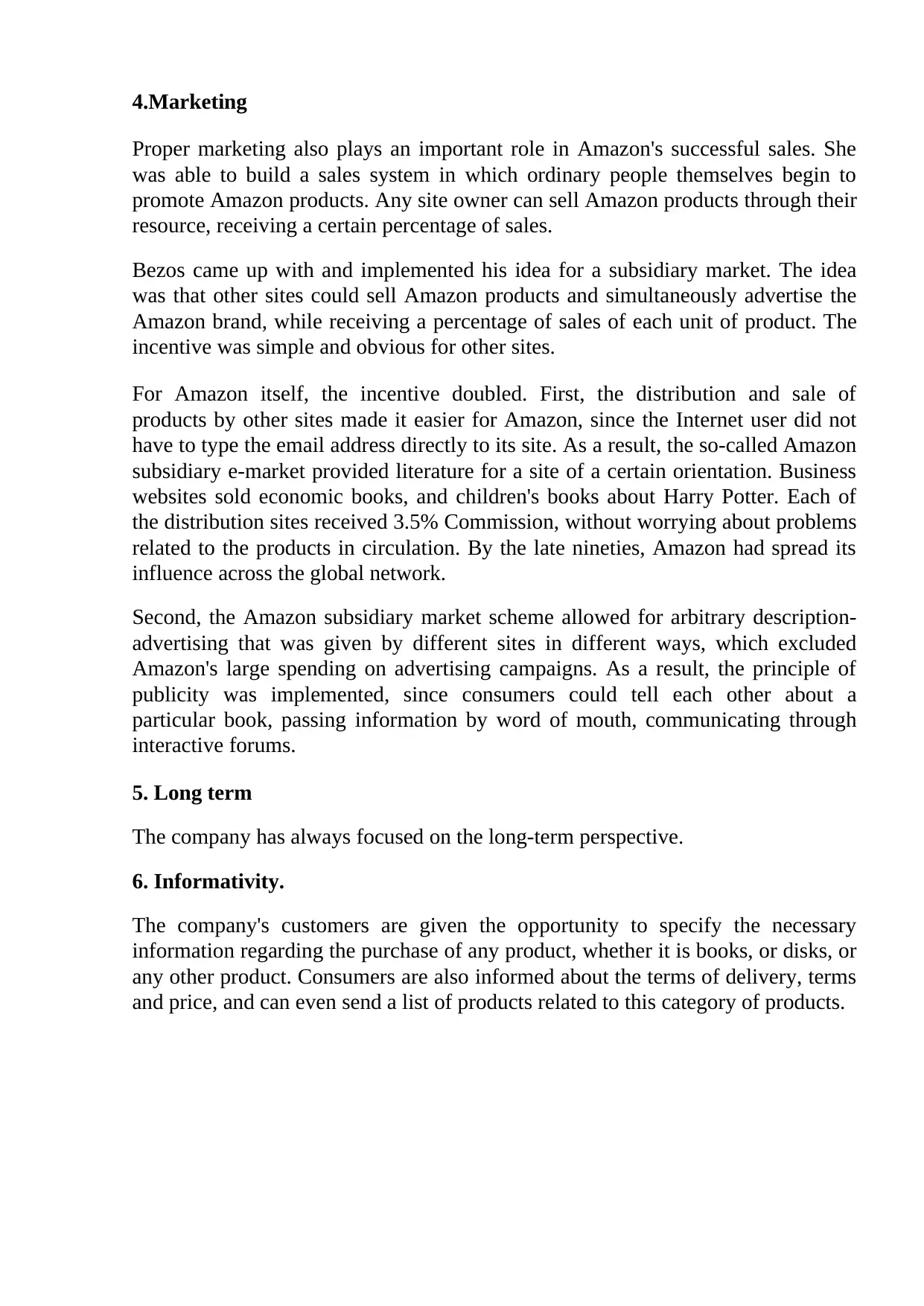
4.Marketing
Proper marketing also plays an important role in Amazon's successful sales. She
was able to build a sales system in which ordinary people themselves begin to
promote Amazon products. Any site owner can sell Amazon products through their
resource, receiving a certain percentage of sales.
Bezos came up with and implemented his idea for a subsidiary market. The idea
was that other sites could sell Amazon products and simultaneously advertise the
Amazon brand, while receiving a percentage of sales of each unit of product. The
incentive was simple and obvious for other sites.
For Amazon itself, the incentive doubled. First, the distribution and sale of
products by other sites made it easier for Amazon, since the Internet user did not
have to type the email address directly to its site. As a result, the so-called Amazon
subsidiary e-market provided literature for a site of a certain orientation. Business
websites sold economic books, and children's books about Harry Potter. Each of
the distribution sites received 3.5% Commission, without worrying about problems
related to the products in circulation. By the late nineties, Amazon had spread its
influence across the global network.
Second, the Amazon subsidiary market scheme allowed for arbitrary description-
advertising that was given by different sites in different ways, which excluded
Amazon's large spending on advertising campaigns. As a result, the principle of
publicity was implemented, since consumers could tell each other about a
particular book, passing information by word of mouth, communicating through
interactive forums.
5. Long term
The company has always focused on the long-term perspective.
6. Informativity.
The company's customers are given the opportunity to specify the necessary
information regarding the purchase of any product, whether it is books, or disks, or
any other product. Consumers are also informed about the terms of delivery, terms
and price, and can even send a list of products related to this category of products.
Proper marketing also plays an important role in Amazon's successful sales. She
was able to build a sales system in which ordinary people themselves begin to
promote Amazon products. Any site owner can sell Amazon products through their
resource, receiving a certain percentage of sales.
Bezos came up with and implemented his idea for a subsidiary market. The idea
was that other sites could sell Amazon products and simultaneously advertise the
Amazon brand, while receiving a percentage of sales of each unit of product. The
incentive was simple and obvious for other sites.
For Amazon itself, the incentive doubled. First, the distribution and sale of
products by other sites made it easier for Amazon, since the Internet user did not
have to type the email address directly to its site. As a result, the so-called Amazon
subsidiary e-market provided literature for a site of a certain orientation. Business
websites sold economic books, and children's books about Harry Potter. Each of
the distribution sites received 3.5% Commission, without worrying about problems
related to the products in circulation. By the late nineties, Amazon had spread its
influence across the global network.
Second, the Amazon subsidiary market scheme allowed for arbitrary description-
advertising that was given by different sites in different ways, which excluded
Amazon's large spending on advertising campaigns. As a result, the principle of
publicity was implemented, since consumers could tell each other about a
particular book, passing information by word of mouth, communicating through
interactive forums.
5. Long term
The company has always focused on the long-term perspective.
6. Informativity.
The company's customers are given the opportunity to specify the necessary
information regarding the purchase of any product, whether it is books, or disks, or
any other product. Consumers are also informed about the terms of delivery, terms
and price, and can even send a list of products related to this category of products.
Secure Best Marks with AI Grader
Need help grading? Try our AI Grader for instant feedback on your assignments.
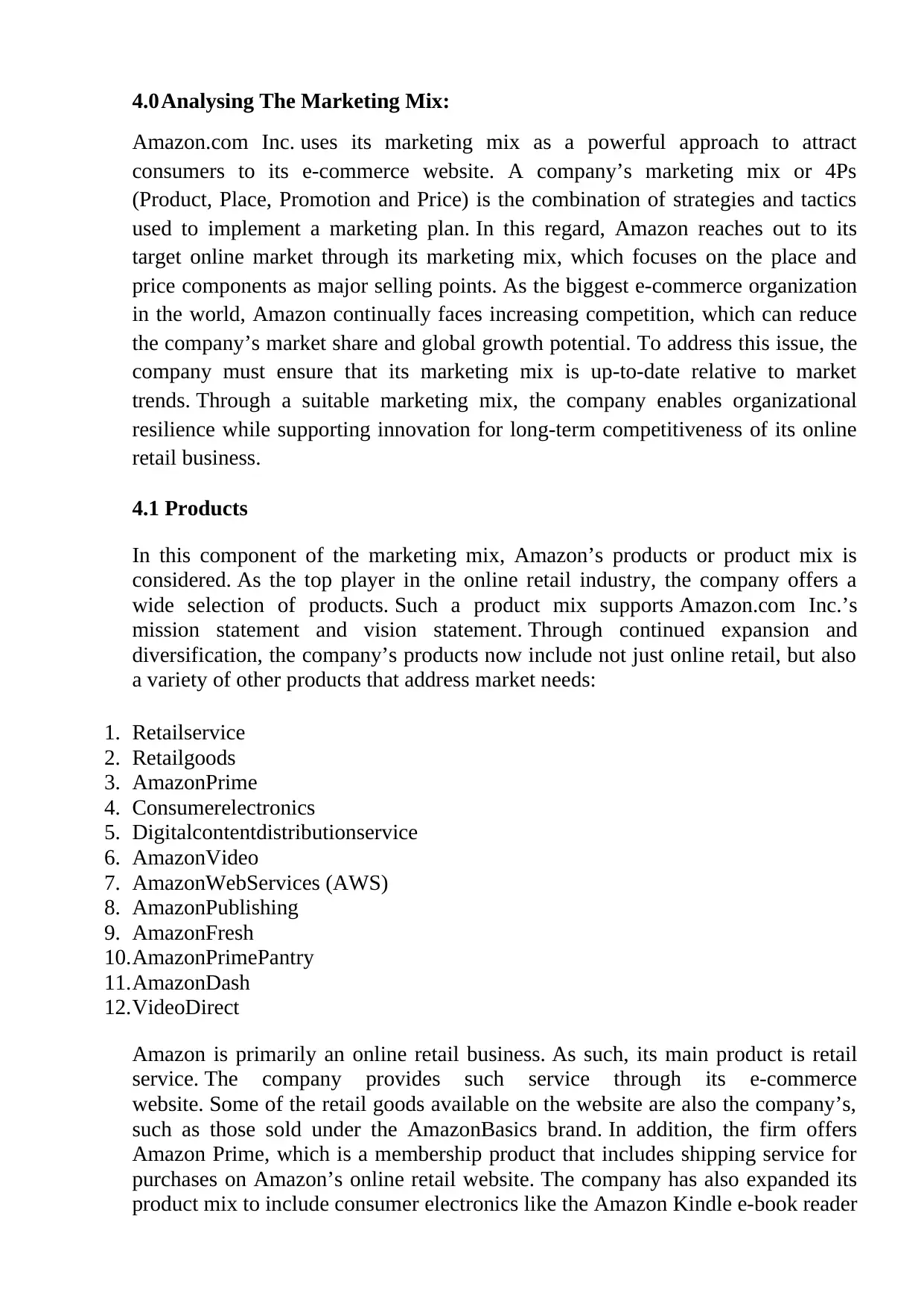
4.0Analysing The Marketing Mix:
Amazon.com Inc. uses its marketing mix as a powerful approach to attract
consumers to its e-commerce website. A company’s marketing mix or 4Ps
(Product, Place, Promotion and Price) is the combination of strategies and tactics
used to implement a marketing plan. In this regard, Amazon reaches out to its
target online market through its marketing mix, which focuses on the place and
price components as major selling points. As the biggest e-commerce organization
in the world, Amazon continually faces increasing competition, which can reduce
the company’s market share and global growth potential. To address this issue, the
company must ensure that its marketing mix is up-to-date relative to market
trends. Through a suitable marketing mix, the company enables organizational
resilience while supporting innovation for long-term competitiveness of its online
retail business.
4.1 Products
In this component of the marketing mix, Amazon’s products or product mix is
considered. As the top player in the online retail industry, the company offers a
wide selection of products. Such a product mix supports Amazon.com Inc.’s
mission statement and vision statement. Through continued expansion and
diversification, the company’s products now include not just online retail, but also
a variety of other products that address market needs:
1. Retailservice
2. Retailgoods
3. AmazonPrime
4. Consumerelectronics
5. Digitalcontentdistributionservice
6. AmazonVideo
7. AmazonWebServices (AWS)
8. AmazonPublishing
9. AmazonFresh
10.AmazonPrimePantry
11.AmazonDash
12.VideoDirect
Amazon is primarily an online retail business. As such, its main product is retail
service. The company provides such service through its e-commerce
website. Some of the retail goods available on the website are also the company’s,
such as those sold under the AmazonBasics brand. In addition, the firm offers
Amazon Prime, which is a membership product that includes shipping service for
purchases on Amazon’s online retail website. The company has also expanded its
product mix to include consumer electronics like the Amazon Kindle e-book reader
Amazon.com Inc. uses its marketing mix as a powerful approach to attract
consumers to its e-commerce website. A company’s marketing mix or 4Ps
(Product, Place, Promotion and Price) is the combination of strategies and tactics
used to implement a marketing plan. In this regard, Amazon reaches out to its
target online market through its marketing mix, which focuses on the place and
price components as major selling points. As the biggest e-commerce organization
in the world, Amazon continually faces increasing competition, which can reduce
the company’s market share and global growth potential. To address this issue, the
company must ensure that its marketing mix is up-to-date relative to market
trends. Through a suitable marketing mix, the company enables organizational
resilience while supporting innovation for long-term competitiveness of its online
retail business.
4.1 Products
In this component of the marketing mix, Amazon’s products or product mix is
considered. As the top player in the online retail industry, the company offers a
wide selection of products. Such a product mix supports Amazon.com Inc.’s
mission statement and vision statement. Through continued expansion and
diversification, the company’s products now include not just online retail, but also
a variety of other products that address market needs:
1. Retailservice
2. Retailgoods
3. AmazonPrime
4. Consumerelectronics
5. Digitalcontentdistributionservice
6. AmazonVideo
7. AmazonWebServices (AWS)
8. AmazonPublishing
9. AmazonFresh
10.AmazonPrimePantry
11.AmazonDash
12.VideoDirect
Amazon is primarily an online retail business. As such, its main product is retail
service. The company provides such service through its e-commerce
website. Some of the retail goods available on the website are also the company’s,
such as those sold under the AmazonBasics brand. In addition, the firm offers
Amazon Prime, which is a membership product that includes shipping service for
purchases on Amazon’s online retail website. The company has also expanded its
product mix to include consumer electronics like the Amazon Kindle e-book reader
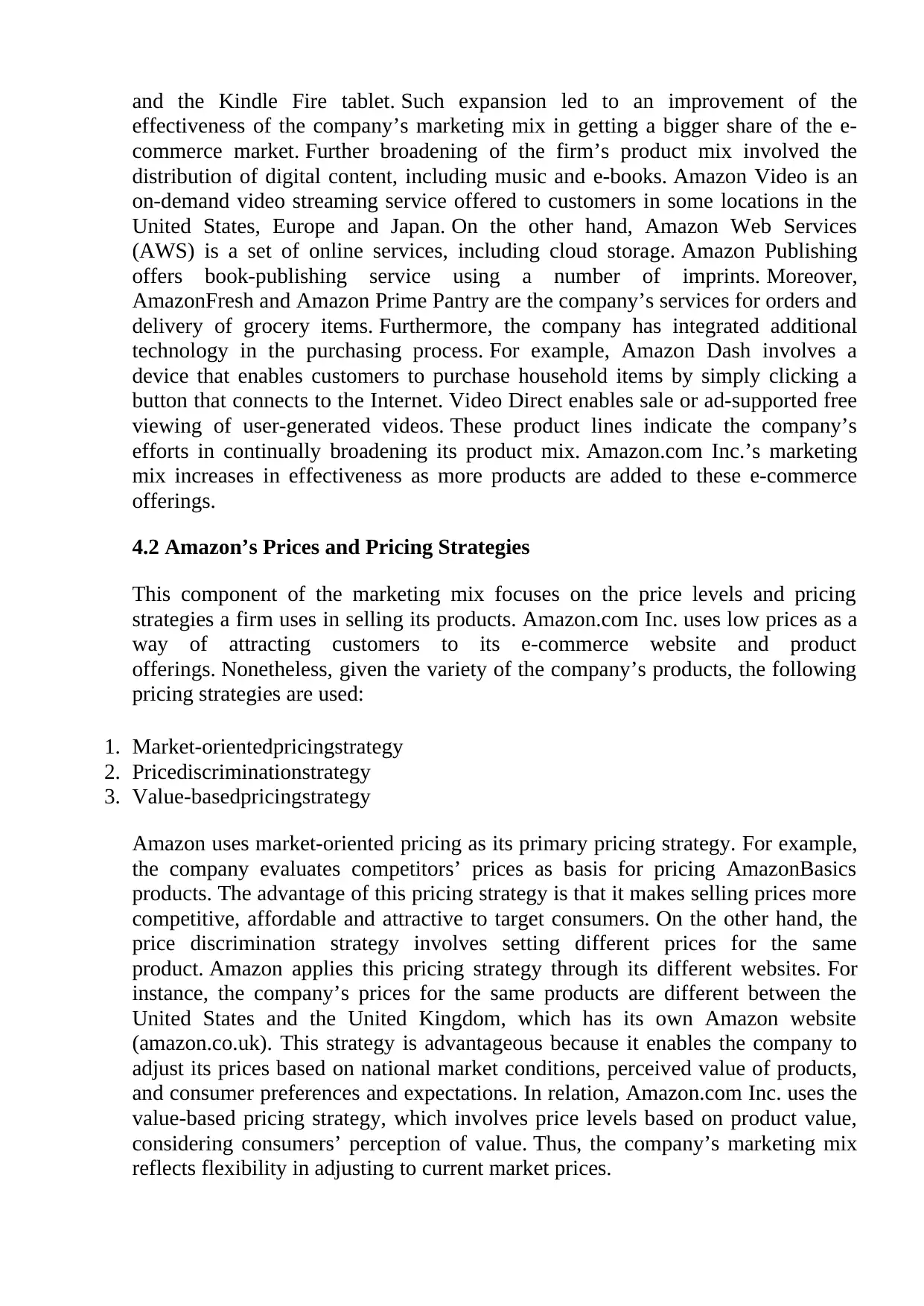
and the Kindle Fire tablet. Such expansion led to an improvement of the
effectiveness of the company’s marketing mix in getting a bigger share of the e-
commerce market. Further broadening of the firm’s product mix involved the
distribution of digital content, including music and e-books. Amazon Video is an
on-demand video streaming service offered to customers in some locations in the
United States, Europe and Japan. On the other hand, Amazon Web Services
(AWS) is a set of online services, including cloud storage. Amazon Publishing
offers book-publishing service using a number of imprints. Moreover,
AmazonFresh and Amazon Prime Pantry are the company’s services for orders and
delivery of grocery items. Furthermore, the company has integrated additional
technology in the purchasing process. For example, Amazon Dash involves a
device that enables customers to purchase household items by simply clicking a
button that connects to the Internet. Video Direct enables sale or ad-supported free
viewing of user-generated videos. These product lines indicate the company’s
efforts in continually broadening its product mix. Amazon.com Inc.’s marketing
mix increases in effectiveness as more products are added to these e-commerce
offerings.
4.2 Amazon’s Prices and Pricing Strategies
This component of the marketing mix focuses on the price levels and pricing
strategies a firm uses in selling its products. Amazon.com Inc. uses low prices as a
way of attracting customers to its e-commerce website and product
offerings. Nonetheless, given the variety of the company’s products, the following
pricing strategies are used:
1. Market-orientedpricingstrategy
2. Pricediscriminationstrategy
3. Value-basedpricingstrategy
Amazon uses market-oriented pricing as its primary pricing strategy. For example,
the company evaluates competitors’ prices as basis for pricing AmazonBasics
products. The advantage of this pricing strategy is that it makes selling prices more
competitive, affordable and attractive to target consumers. On the other hand, the
price discrimination strategy involves setting different prices for the same
product. Amazon applies this pricing strategy through its different websites. For
instance, the company’s prices for the same products are different between the
United States and the United Kingdom, which has its own Amazon website
(amazon.co.uk). This strategy is advantageous because it enables the company to
adjust its prices based on national market conditions, perceived value of products,
and consumer preferences and expectations. In relation, Amazon.com Inc. uses the
value-based pricing strategy, which involves price levels based on product value,
considering consumers’ perception of value. Thus, the company’s marketing mix
reflects flexibility in adjusting to current market prices.
effectiveness of the company’s marketing mix in getting a bigger share of the e-
commerce market. Further broadening of the firm’s product mix involved the
distribution of digital content, including music and e-books. Amazon Video is an
on-demand video streaming service offered to customers in some locations in the
United States, Europe and Japan. On the other hand, Amazon Web Services
(AWS) is a set of online services, including cloud storage. Amazon Publishing
offers book-publishing service using a number of imprints. Moreover,
AmazonFresh and Amazon Prime Pantry are the company’s services for orders and
delivery of grocery items. Furthermore, the company has integrated additional
technology in the purchasing process. For example, Amazon Dash involves a
device that enables customers to purchase household items by simply clicking a
button that connects to the Internet. Video Direct enables sale or ad-supported free
viewing of user-generated videos. These product lines indicate the company’s
efforts in continually broadening its product mix. Amazon.com Inc.’s marketing
mix increases in effectiveness as more products are added to these e-commerce
offerings.
4.2 Amazon’s Prices and Pricing Strategies
This component of the marketing mix focuses on the price levels and pricing
strategies a firm uses in selling its products. Amazon.com Inc. uses low prices as a
way of attracting customers to its e-commerce website and product
offerings. Nonetheless, given the variety of the company’s products, the following
pricing strategies are used:
1. Market-orientedpricingstrategy
2. Pricediscriminationstrategy
3. Value-basedpricingstrategy
Amazon uses market-oriented pricing as its primary pricing strategy. For example,
the company evaluates competitors’ prices as basis for pricing AmazonBasics
products. The advantage of this pricing strategy is that it makes selling prices more
competitive, affordable and attractive to target consumers. On the other hand, the
price discrimination strategy involves setting different prices for the same
product. Amazon applies this pricing strategy through its different websites. For
instance, the company’s prices for the same products are different between the
United States and the United Kingdom, which has its own Amazon website
(amazon.co.uk). This strategy is advantageous because it enables the company to
adjust its prices based on national market conditions, perceived value of products,
and consumer preferences and expectations. In relation, Amazon.com Inc. uses the
value-based pricing strategy, which involves price levels based on product value,
considering consumers’ perception of value. Thus, the company’s marketing mix
reflects flexibility in adjusting to current market prices.

4.3 Promotion
This component of the marketing mix involves the strategies and tactics that a
company uses to communicate with its target market. Amazon.com Inc. aims to
persuade its customers to visit its websites and pay for its online services. The
following strategies and tactics are used in such promotional mix, arranged
according to importance in the company’s e-commerce business:
1. Advertising (mostimportant)
2. Salespromotions
3. Publicrelations
4. Directmarketing
Advertising functions as the primary means for Amazon to communicate with its
target market. For example, the company has an affiliate program for website
owners or online publishers to earn revenues by displaying advertisements and
corresponding links to products sold on the Amazon.com website. This strategy
widens the company’s market reach. Also, Amazon.com Inc. applies sales
promotion as a secondary strategy to attract customers and persuade them to
purchase goods and services on the website. For example, the company
occasionally uses discounts and special offers to generate more sales. On the other
hand, the firm strengthens its brand image through public relations programs, such
as Amazon Smile, which donates a percentage of sales to charitable
organizations. These programs enhance consumer perception about the corporation
[Read: Amazon’s Stakeholders & Corporate Social Responsibility
Strategy]. Moreover, in using direct marketing, the company directly
communicates with businesses to offer its online services, such as publishing and
digital content distribution. In this component of Amazon.com Inc.’s marketing
mix, advertising is the main determinant of the organization’s marketing
communication effectiveness.
4.4 Place/Distribution
The venues used to reach target customers are identified in this component of the
marketing mix. Amazon.com Inc. is a mainly online business organization.
Nonetheless, the company uses the following places to reach its e-commerce
customers:
1. Official e-commercewebsites
2. AmazonBooks
3. Others
This component of the marketing mix involves the strategies and tactics that a
company uses to communicate with its target market. Amazon.com Inc. aims to
persuade its customers to visit its websites and pay for its online services. The
following strategies and tactics are used in such promotional mix, arranged
according to importance in the company’s e-commerce business:
1. Advertising (mostimportant)
2. Salespromotions
3. Publicrelations
4. Directmarketing
Advertising functions as the primary means for Amazon to communicate with its
target market. For example, the company has an affiliate program for website
owners or online publishers to earn revenues by displaying advertisements and
corresponding links to products sold on the Amazon.com website. This strategy
widens the company’s market reach. Also, Amazon.com Inc. applies sales
promotion as a secondary strategy to attract customers and persuade them to
purchase goods and services on the website. For example, the company
occasionally uses discounts and special offers to generate more sales. On the other
hand, the firm strengthens its brand image through public relations programs, such
as Amazon Smile, which donates a percentage of sales to charitable
organizations. These programs enhance consumer perception about the corporation
[Read: Amazon’s Stakeholders & Corporate Social Responsibility
Strategy]. Moreover, in using direct marketing, the company directly
communicates with businesses to offer its online services, such as publishing and
digital content distribution. In this component of Amazon.com Inc.’s marketing
mix, advertising is the main determinant of the organization’s marketing
communication effectiveness.
4.4 Place/Distribution
The venues used to reach target customers are identified in this component of the
marketing mix. Amazon.com Inc. is a mainly online business organization.
Nonetheless, the company uses the following places to reach its e-commerce
customers:
1. Official e-commercewebsites
2. AmazonBooks
3. Others
Paraphrase This Document
Need a fresh take? Get an instant paraphrase of this document with our AI Paraphraser
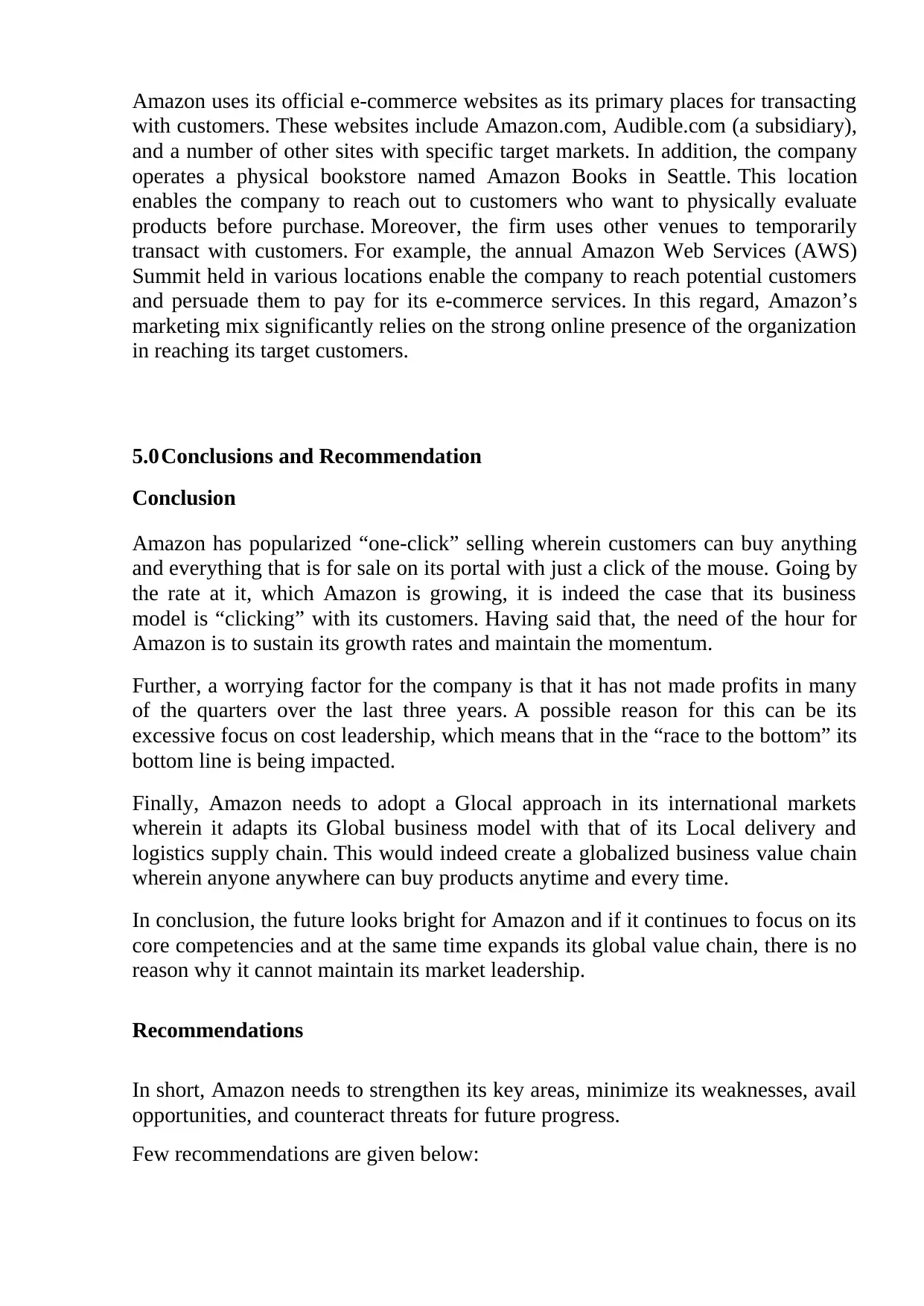
Amazon uses its official e-commerce websites as its primary places for transacting
with customers. These websites include Amazon.com, Audible.com (a subsidiary),
and a number of other sites with specific target markets. In addition, the company
operates a physical bookstore named Amazon Books in Seattle. This location
enables the company to reach out to customers who want to physically evaluate
products before purchase. Moreover, the firm uses other venues to temporarily
transact with customers. For example, the annual Amazon Web Services (AWS)
Summit held in various locations enable the company to reach potential customers
and persuade them to pay for its e-commerce services. In this regard, Amazon’s
marketing mix significantly relies on the strong online presence of the organization
in reaching its target customers.
5.0Conclusions and Recommendation
Conclusion
Amazon has popularized “one-click” selling wherein customers can buy anything
and everything that is for sale on its portal with just a click of the mouse. Going by
the rate at it, which Amazon is growing, it is indeed the case that its business
model is “clicking” with its customers. Having said that, the need of the hour for
Amazon is to sustain its growth rates and maintain the momentum.
Further, a worrying factor for the company is that it has not made profits in many
of the quarters over the last three years. A possible reason for this can be its
excessive focus on cost leadership, which means that in the “race to the bottom” its
bottom line is being impacted.
Finally, Amazon needs to adopt a Glocal approach in its international markets
wherein it adapts its Global business model with that of its Local delivery and
logistics supply chain. This would indeed create a globalized business value chain
wherein anyone anywhere can buy products anytime and every time.
In conclusion, the future looks bright for Amazon and if it continues to focus on its
core competencies and at the same time expands its global value chain, there is no
reason why it cannot maintain its market leadership.
Recommendations
In short, Amazon needs to strengthen its key areas, minimize its weaknesses, avail
opportunities, and counteract threats for future progress.
Few recommendations are given below:
with customers. These websites include Amazon.com, Audible.com (a subsidiary),
and a number of other sites with specific target markets. In addition, the company
operates a physical bookstore named Amazon Books in Seattle. This location
enables the company to reach out to customers who want to physically evaluate
products before purchase. Moreover, the firm uses other venues to temporarily
transact with customers. For example, the annual Amazon Web Services (AWS)
Summit held in various locations enable the company to reach potential customers
and persuade them to pay for its e-commerce services. In this regard, Amazon’s
marketing mix significantly relies on the strong online presence of the organization
in reaching its target customers.
5.0Conclusions and Recommendation
Conclusion
Amazon has popularized “one-click” selling wherein customers can buy anything
and everything that is for sale on its portal with just a click of the mouse. Going by
the rate at it, which Amazon is growing, it is indeed the case that its business
model is “clicking” with its customers. Having said that, the need of the hour for
Amazon is to sustain its growth rates and maintain the momentum.
Further, a worrying factor for the company is that it has not made profits in many
of the quarters over the last three years. A possible reason for this can be its
excessive focus on cost leadership, which means that in the “race to the bottom” its
bottom line is being impacted.
Finally, Amazon needs to adopt a Glocal approach in its international markets
wherein it adapts its Global business model with that of its Local delivery and
logistics supply chain. This would indeed create a globalized business value chain
wherein anyone anywhere can buy products anytime and every time.
In conclusion, the future looks bright for Amazon and if it continues to focus on its
core competencies and at the same time expands its global value chain, there is no
reason why it cannot maintain its market leadership.
Recommendations
In short, Amazon needs to strengthen its key areas, minimize its weaknesses, avail
opportunities, and counteract threats for future progress.
Few recommendations are given below:
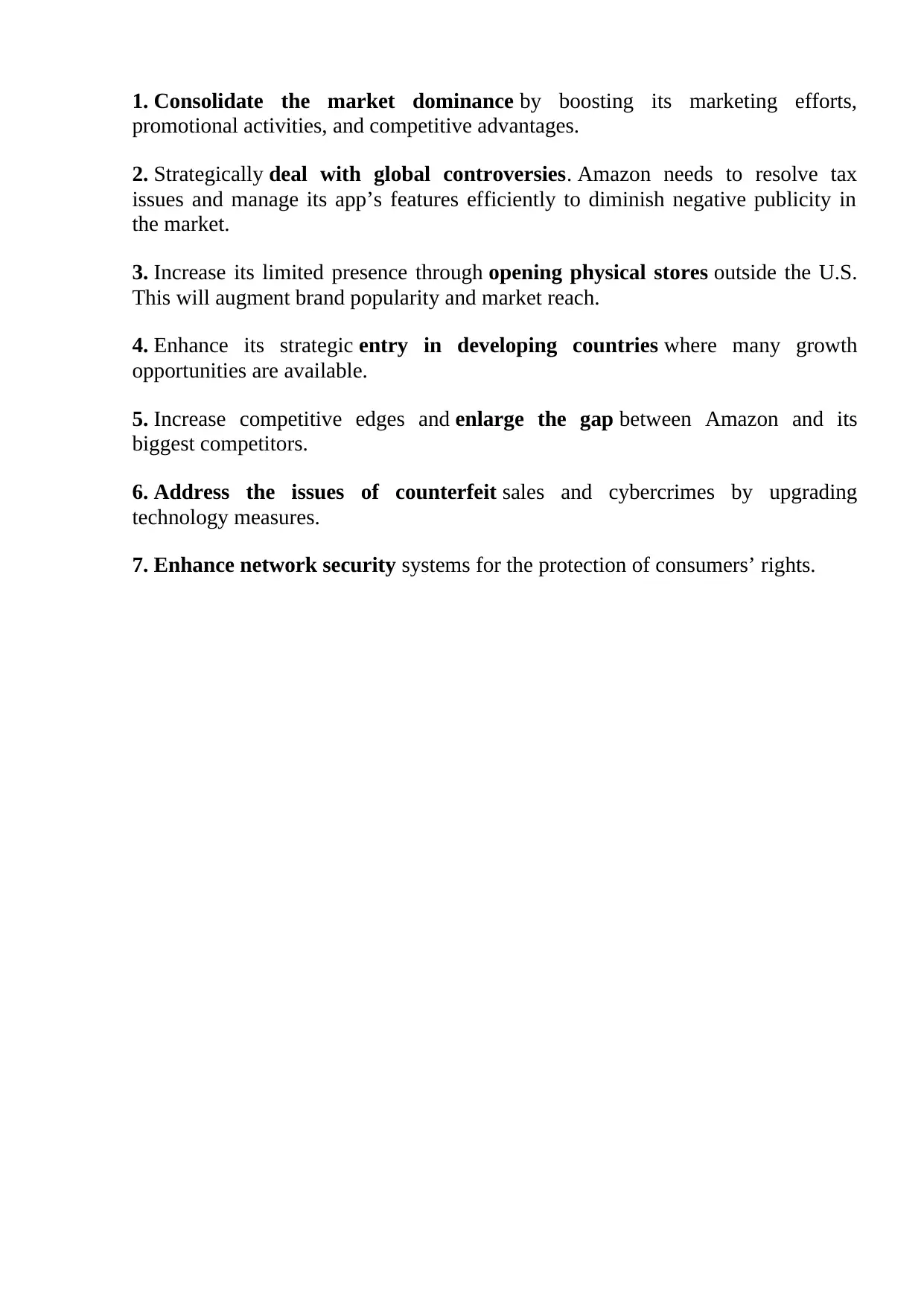
1. Consolidate the market dominance by boosting its marketing efforts,
promotional activities, and competitive advantages.
2. Strategically deal with global controversies. Amazon needs to resolve tax
issues and manage its app’s features efficiently to diminish negative publicity in
the market.
3. Increase its limited presence through opening physical stores outside the U.S.
This will augment brand popularity and market reach.
4. Enhance its strategic entry in developing countries where many growth
opportunities are available.
5. Increase competitive edges and enlarge the gap between Amazon and its
biggest competitors.
6. Address the issues of counterfeit sales and cybercrimes by upgrading
technology measures.
7. Enhance network security systems for the protection of consumers’ rights.
promotional activities, and competitive advantages.
2. Strategically deal with global controversies. Amazon needs to resolve tax
issues and manage its app’s features efficiently to diminish negative publicity in
the market.
3. Increase its limited presence through opening physical stores outside the U.S.
This will augment brand popularity and market reach.
4. Enhance its strategic entry in developing countries where many growth
opportunities are available.
5. Increase competitive edges and enlarge the gap between Amazon and its
biggest competitors.
6. Address the issues of counterfeit sales and cybercrimes by upgrading
technology measures.
7. Enhance network security systems for the protection of consumers’ rights.
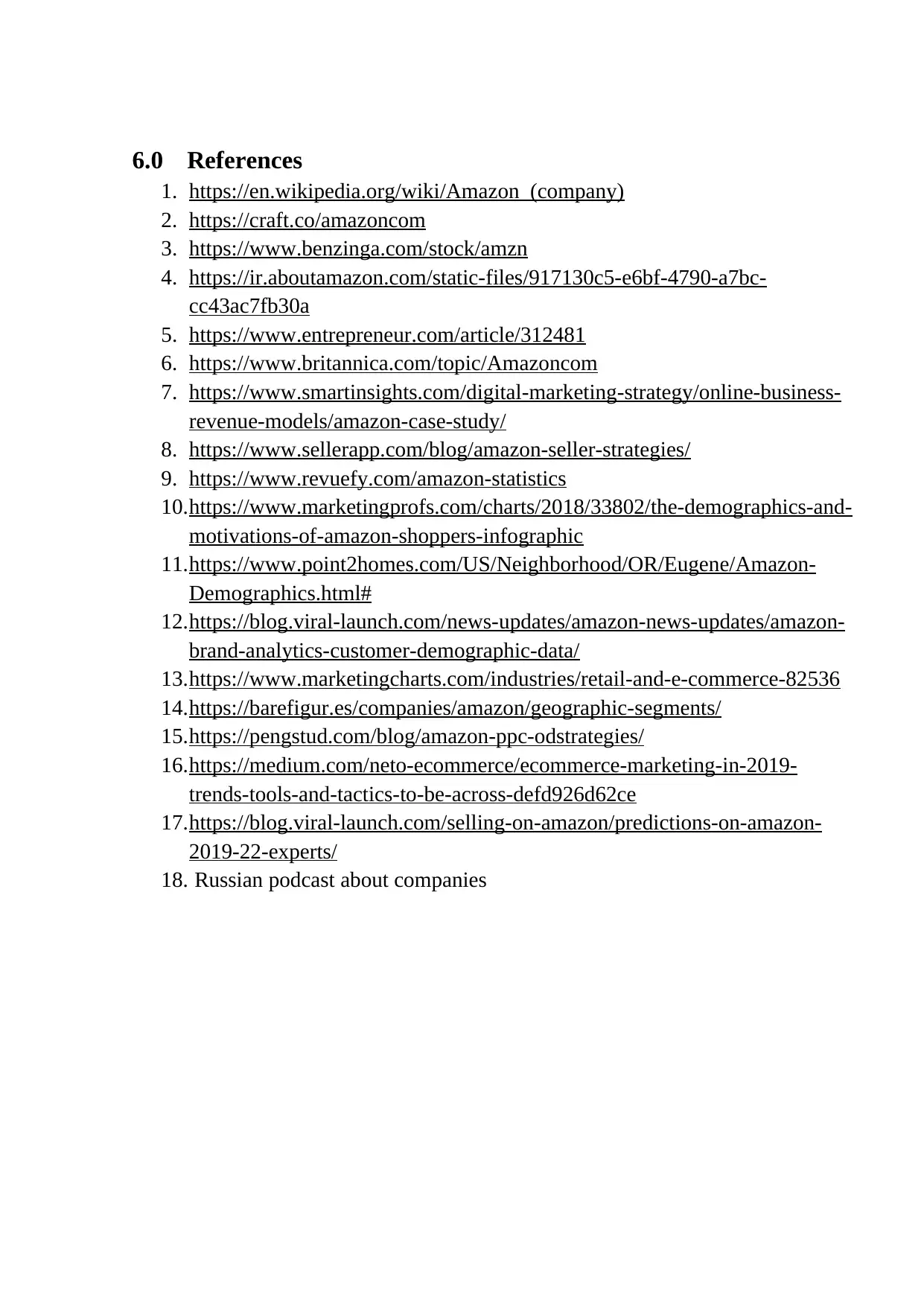
6.0 References
1. https://en.wikipedia.org/wiki/Amazon_(company)
2. https://craft.co/amazoncom
3. https://www.benzinga.com/stock/amzn
4. https://ir.aboutamazon.com/static-files/917130c5-e6bf-4790-a7bc-
cc43ac7fb30a
5. https://www.entrepreneur.com/article/312481
6. https://www.britannica.com/topic/Amazoncom
7. https://www.smartinsights.com/digital-marketing-strategy/online-business-
revenue-models/amazon-case-study/
8. https://www.sellerapp.com/blog/amazon-seller-strategies/
9. https://www.revuefy.com/amazon-statistics
10.https://www.marketingprofs.com/charts/2018/33802/the-demographics-and-
motivations-of-amazon-shoppers-infographic
11.https://www.point2homes.com/US/Neighborhood/OR/Eugene/Amazon-
Demographics.html#
12.https://blog.viral-launch.com/news-updates/amazon-news-updates/amazon-
brand-analytics-customer-demographic-data/
13.https://www.marketingcharts.com/industries/retail-and-e-commerce-82536
14.https://barefigur.es/companies/amazon/geographic-segments/
15.https://pengstud.com/blog/amazon-ppc-odstrategies/
16.https://medium.com/neto-ecommerce/ecommerce-marketing-in-2019-
trends-tools-and-tactics-to-be-across-defd926d62ce
17.https://blog.viral-launch.com/selling-on-amazon/predictions-on-amazon-
2019-22-experts/
18. Russian podcast about companies
1. https://en.wikipedia.org/wiki/Amazon_(company)
2. https://craft.co/amazoncom
3. https://www.benzinga.com/stock/amzn
4. https://ir.aboutamazon.com/static-files/917130c5-e6bf-4790-a7bc-
cc43ac7fb30a
5. https://www.entrepreneur.com/article/312481
6. https://www.britannica.com/topic/Amazoncom
7. https://www.smartinsights.com/digital-marketing-strategy/online-business-
revenue-models/amazon-case-study/
8. https://www.sellerapp.com/blog/amazon-seller-strategies/
9. https://www.revuefy.com/amazon-statistics
10.https://www.marketingprofs.com/charts/2018/33802/the-demographics-and-
motivations-of-amazon-shoppers-infographic
11.https://www.point2homes.com/US/Neighborhood/OR/Eugene/Amazon-
Demographics.html#
12.https://blog.viral-launch.com/news-updates/amazon-news-updates/amazon-
brand-analytics-customer-demographic-data/
13.https://www.marketingcharts.com/industries/retail-and-e-commerce-82536
14.https://barefigur.es/companies/amazon/geographic-segments/
15.https://pengstud.com/blog/amazon-ppc-odstrategies/
16.https://medium.com/neto-ecommerce/ecommerce-marketing-in-2019-
trends-tools-and-tactics-to-be-across-defd926d62ce
17.https://blog.viral-launch.com/selling-on-amazon/predictions-on-amazon-
2019-22-experts/
18. Russian podcast about companies
Secure Best Marks with AI Grader
Need help grading? Try our AI Grader for instant feedback on your assignments.

Appendices
Market Summary:
№ 1 (5 years)
№ 2 (1 year)
Market Summary:
№ 1 (5 years)
№ 2 (1 year)
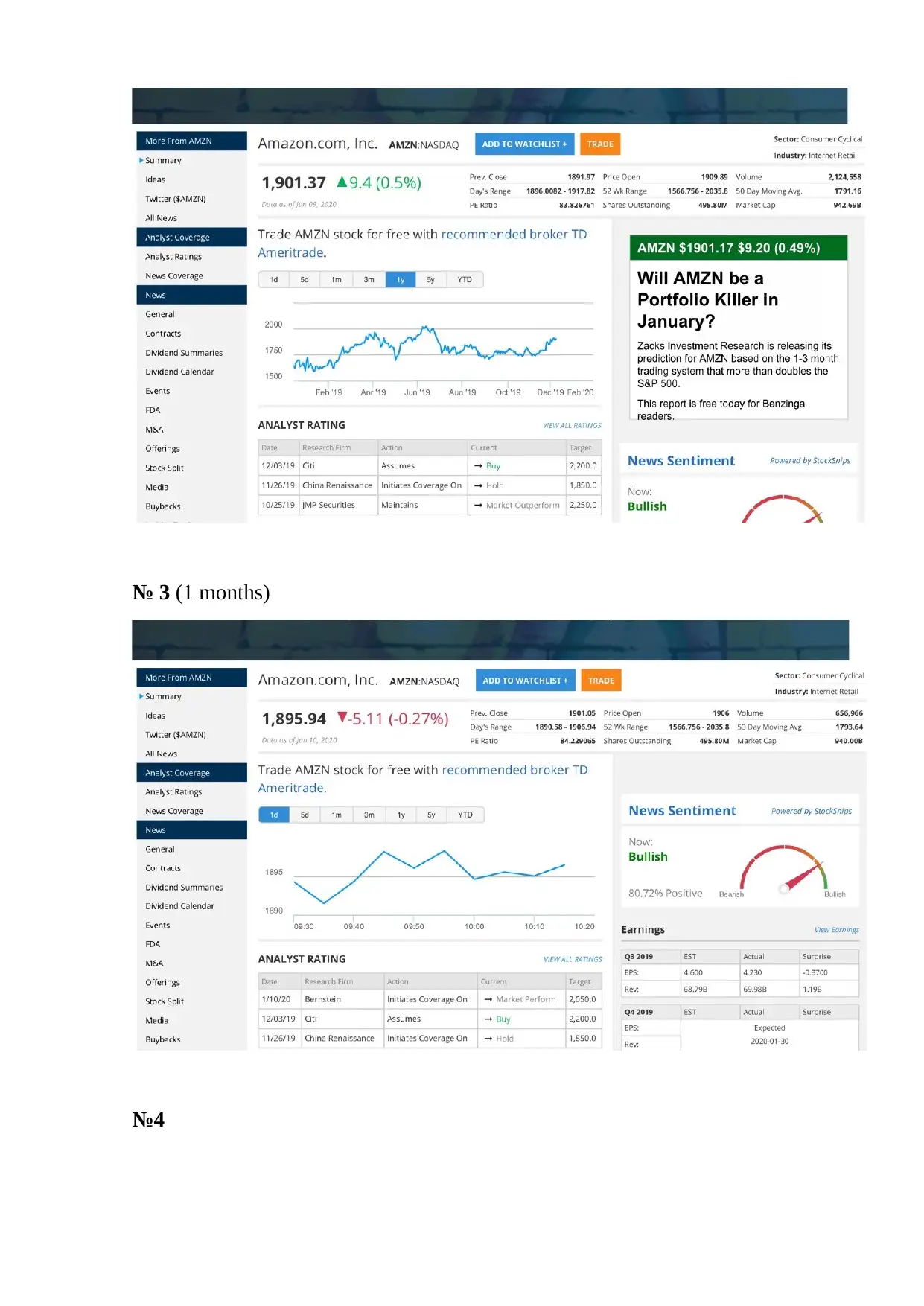
№ 3 (1 months)
№4
№4
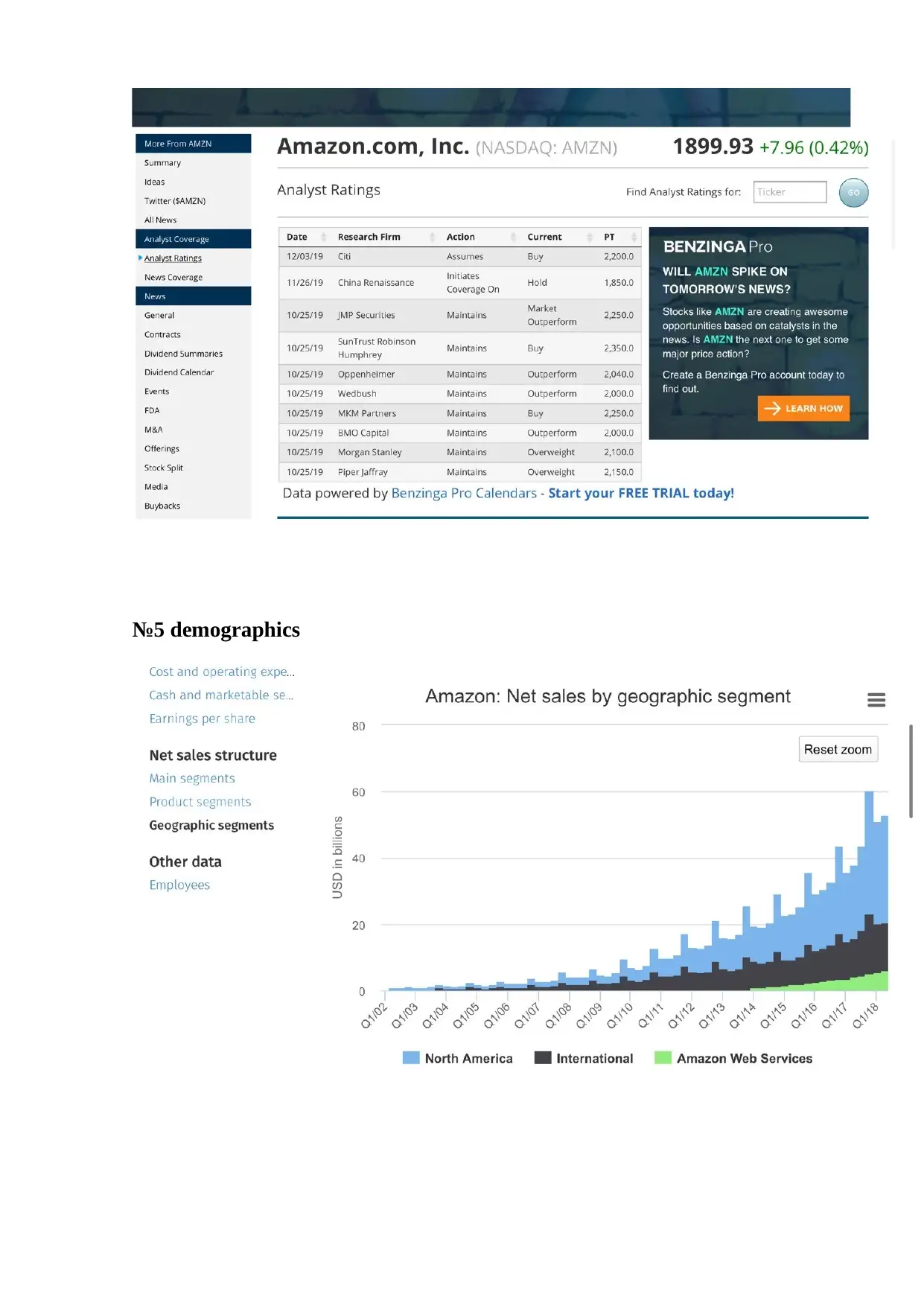
№5 demographics
Paraphrase This Document
Need a fresh take? Get an instant paraphrase of this document with our AI Paraphraser

№6
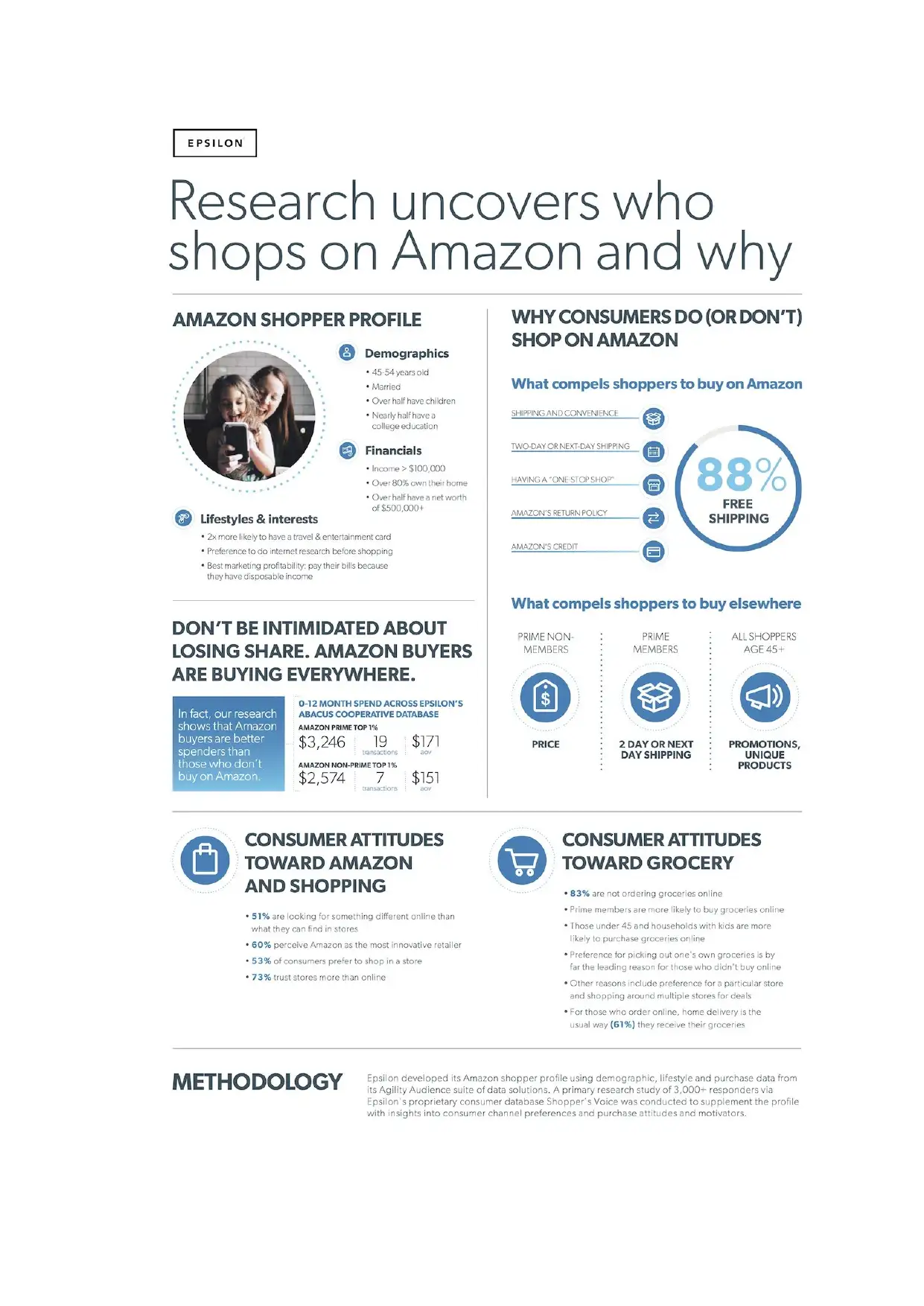
1 out of 27
Related Documents
Your All-in-One AI-Powered Toolkit for Academic Success.
+13062052269
info@desklib.com
Available 24*7 on WhatsApp / Email
![[object Object]](/_next/static/media/star-bottom.7253800d.svg)
Unlock your academic potential
© 2024 | Zucol Services PVT LTD | All rights reserved.





